#and very different to what I’m used to (1890s-1900s)
Text
“i love doing costume designs” I say, as I once again design costumes which aren’t the actual costume designs I’m meant to do by september
#I’ve done prelims for my drama coursework I just have to do more refined designs#it would be a lot more helpful if my group had blocked or conceptualised any scenes yet#man :/#in other news detective noir au kath designs have been fun to cook up#late 1920s fashion is fun#and very different to what I’m used to (1890s-1900s)#so overall :’)#davey rambles
2 notes
·
View notes
Text
Ok, so I know that we still know pretty much nothing about Alastor’s human life, and Rosie’s if she had one, but there’s so many reasons their dynamic is peak. Before I start I’ll once more reiterate that I’m not 100% certain of any of this but-
Alastor and Rosie seem to come from a similar time period. With Alastor living in the early 1900s and probs dying in 1920s or 30s in New Orleans. Rosie and her town seem to be based on ‘Hello, Dolly’ (ep 7 title even alludes to this) which was based in New York in 1890s. So not only would Alastor and Rosie likely never have the chance to meet in life but there’d also be a roughly 20 or more year difference between them. What I’m getting at is that while they’re so perfectly matched they’d never really be able to interact the way they do in hell if they were alive. Like imagine 20 yo Al dancing/gossiping/whatever with a 40-50 yo Rosie, while cute to us they’d probs be considered weird for their friendship, let alone a potential (lavender) marriage.
If Rosie was once a human then I’d imagine just like Alastor her cannibalism in hell would come from her interest in it from when she was alive. So that’d mean in life she’d likely also be a serial killer cannibal, just like Al. This creates a funny situation where they just so happen to be the exact same type of serial killer, meaning they lead very similar lifestyles and only they would actually understand this twisted part about each other.
Then in hell Rosie recreates and manages to maintain the early 1900s look and culture in her turf, but makes it cannibal friendly (lol). In this way kind of creating the perfect corner of hell for herself (and also Alastor).
What I’m getting at is that they’re qp soulmates who can meet and freely interact in an afterlife that’s kinda perfect for them (including the part where they’re allowed to be cruel). Like when ppl say you’ll meet your soulmate in heaven but those two are crazy so for them it’s meeting their perfect soulmate in hell.
#if rosie gets confirmed as hellborn then a bunch of this stuff changes a bit but mostly stays intact#like they’re still de facto serial killer cannibals together who are qp goals and can only be together in hell#with rosie and her town being the perfect paradise for Al lol#hazbin hotel#hazbin hotel alastor#hazbin hotel rosie#hazbin alastor#hazbin rosie#alastor#rosie#my:hazbin hotel#alastor and rosie#radiorose
384 notes
·
View notes
Note
some sbr (and phantom blood!) thoughts for you in general, your highness, if you'll take the words of this lowly peon--
i've been watching some documentaries on the gilded age recently, and a thought came up on me; how would the blorbos of the sbr and phantom blood era handle the societal expectations of the era?
like, they can't really be affectionate or anything in public, so i feel like some of the pda/jealous ones would really struggle. plus, it would be inconvienent for them to talk to darling, especially because an engaged couple or even just two single people weren't really allowed to commune with eachother in private in anything other then social occasions.
it's a fascinating dilemma, really, and i'd be fascinated to here about how some yanderes from this time period would handle this stuff.
your ever faithful, ever loyal, ever miserable peon--
🌸 anon
Warning for discussion of gender roles, brief homophobia mention I'm not sure if you can count it really, typical yandere things.
What a good ask, peon. When I think of the old American west, I tend to think of those old cowboy movies focusing on the wild west. What a wild three decades.
We have to consider where exactly they are in the world, and their social standing. Frilly fan language means absolutely nothing to someone who grew up on the streets- Although Dio has studied aristocratic courting rituals religiously. England and the US are different culturally, and the south is very different from the west and north.
The Gilded age takes place from 1877-1900-ish, doesn’t it? Steel Ball Run takes place right in the middle of that, starting in 1890 and ending a year later. I tend to think of the Steel Ball Run cast as living in the ‘wild west,’ which takes place generally from 1865 to 1895, so it’s perfectly lined up. Phantom Blood’s main story is in 1888, but considering it’s entirely in England, it would be considered late Victorian era rather than the Gilded age. The entire concept of a débutante is so horrifying in a yandere context. If I’m misremembering and the entire concept of presenting a young lady to society for the purpose of marrying her off is not in the late Victorian era, or any of the other information I just presented is incorrect, ignore the inaccuracy. Débutante is used in a gender neutral way here I pinky swear.
Jonathan takes the entire courting process very seriously. Not that he’s any good at formalities, but there’s an attempt. The concept of marriage being something romantic was very new in the Victorian period- but not a foreign concept to Jonathan in the slightest. He grew up with a loving family, his future spouse should be the love of his life. It was generally important to the male identity to be educated, do a sport, and be a gentleman- Jonathan fits every one of those requirements. By all means, he fits in. The only thing stopping him from never getting a second glance is how eager he is to please his darling. “It’s odd how that boy follows his darling around like a dog all day.” is a common statement from those who recognize him happily trotting down the street to go see you- that’s right. He’ll walk instead of taking a carriage. He doesn’t want the visit to feel so formal, he really just wants to spend time with you, even if you aren’t out in society yet. Jonathan thinks it’s going to help his chances of being formally introduced to you when you really become a débutante- but it is not. Gifts, flowers, attention, it all comes off as too much. He mopes a bit when his efforts are proven to be futile, but that doesn’t mean that he’s discouraged. Well, it doesn’t matter, he can always just propose. Why would your parents turn down a proposal from a Joestar, who can take care of you forever?
Erina tends to be rather shy. She sincerely prays that she’s caught your eye- and does just about everything she can think of to get it. She’s quite the stalker. Your interests are her interests! She’ll show up at any sport you play just to watch you and show you she’s right there to support you, even if she avoids directly speaking to you for quite some time. It’s improper, and she doesn’t want to come across as needy, or socially inept. She can hope, though. Maybe if she just keeps showing up in places she knows you’ll be. The best day of her life is likely the day you come to a débutante ball, assuming you’re of the same social class. She hovers quite a bit, and takes a moment to beg whatever God is out there to introduce you to her. When her wish is granted, she clings to you for the rest of the night, regardless of what is and is not appropriate.
Dio is a man obsessed with social standing. When you’re denied something for so long, it’s obvious that you’d become infatuated until you get it. Dio’s temperament is closer to obsession; Even when Dio reached his comfortable spot, he still wanted more. He actually takes courting rather seriously in his youth, he does it the proper way. He waits until you’ve been formally introduced to society, and makes his initial move. Just one dance will do. He doesn’t want to come off as desperate- Despite being at every single ball you’ve ever attended, sans one or two for his reputation’s sake. He’ll only visit your home on the proper days, always brings gorgeous, full bouquets, and leaves within forty-five minutes. He’s not about to take up your entire afternoon, but he’s not about to let another suitor talk your ear off for that long, either. Whatever hobby you’ve taken up is his greatest interest for today’s conversation. When you see him in public he’ll offer a polite smile, but nothing more. Of course, this all goes out the window when he turns, since he can just take you with absolutely no repercussions.
Johnny is always going to treat the world like it’s Danville, Kentucky. His stay in England didn’t have any effect on him development-wise, he sounds like he’s from Kentucky still, too. All that bullshit about waiting around for the chance to dance with his darling is his own personal nightmare- and it isn’t going to happen anytime soon. He has a bit of a ‘modern’ take on dating, if you could call it that. He’s not as obviously affectionate as someone like Gyro, but it’s not like there’s a lack of it. He’ll hold his darling’s hand while you wait in line, he’ll whine until you sit with him on his horse, he can’t sleep unless you’re right there… Johnny’s pretty forward, regardless of what society deems is fine. He’s a good boy, especially in his prime- there’s no reason for your family to not like him. If your family isn’t accepting of him… he doesn’t really want their blessing, anyway.
Gyro has adapted fairly well to life in America, but not when it comes to the culture shock of not being able to cling to his darling constantly. Whether or not his explanation of how being overly affectionate is the norm back home is true is up for debate. He loves to hang on his darling- putting his head on top of yours while you try to talk to some poor stranger is one of his preferred pastimes. Gyro does plan on returning home eventually, but he has some things to do here before he can- one of those things being finding a way to take you back with him. Gyro’s not really put off by getting told to stop, truly, what are you going to do about it? Are you going to get in the way of him and his darling? Don’t be stupid. Gyro will listen to his darling’s request to not have as much pda if you genuinely compromise with him. No pda, but full access to you in privacy? Cool, cool, we’re never going out again. Gyro gets his fill in little ways, he wants to at least hold hands, or be able to put his hand on your waist. You’re seriously denying him what he needs because it isn’t “socially acceptable”?? You’re being ridiculous. Gyro won’t humor silly courting rules because it’s what you’re used to, he’s right here, you’re right here, if the only thing between you is some traditions, then Gyro has nothing in his way.
Firstly, Hotpants does not really acknowledge societal norms. She’s taking on the “man’s” role in the relationship anyway, so if her darling is feminine, it could pass as a “typical” relationship, as long as she’s presenting herself in a masculine way. She gets weird looks when she goes to get dinner for the two of you- she catches, you cook. People often try to haggle her when she needs to buy new gear, it’s annoying. It’s actually a giant pain in the ass for her, but it’s worth it if it’s to provide for you. Hotpants isn’t really interested in the whole courting process, she’s very quick to snatch her darling up and lock them somewhere safe, even if you're not sure who she is. You can play housespouse for her while she takes care of what she needs to, you’re being given the easy life, is it really that bad? She’s not even forcing you to be affectionate with her- just stay put and listen to what she tells you to do. You can even write to your family, if you want, just know that she’s going to skim it over to make sure it’s appropriate. You’ll even have some time alone while she goes out for the day- interrupted by the sound of her boots and the sight of her jacket hung up by the door. When you are eventually let out- Likely to transport you somewhere else, I cannot see Hotpants letting her darling back out again- she’s a bit cold, but firm. If you can be trusted to sit still, she’ll let you ride her horse while she guides it. If you cannot, she’ll ride with you, arms around your sides.
#I love you Miss Hotpants.#hotpants ♡♡♡#♡♡♡♡♡♡♡♡♡♡♡♡♡♡#request granted#yandere jonathan joestar#yandere erina pendleton#yandere dio#yandere johnny joestar#yandere gyro zeppeli#yandere hotpants#🌸 anon
51 notes
·
View notes
Text
Historical Research on the Wild West Chapter of Live-A-Live!
(That no one asked for, but you’re getting anyway hehe)
So first, I really want to be able to securely say around what year this chapter takes place in. Just judging from the whole setting it’s likely somewhere from the late 1800s to early 1900s. But can we get more specific? Uh, yes and no.
Let’s look at Sundown and Mad Dog’s pistols!


So the Colt Single Action Army (aka “Peacemaker”) was first produced in 1873-1941. Assuming that Sundown has the first version of the pistol and assuming their story doesn’t take place in the 1950s, we know that the chapter takes place in those years.
Now, Mad Dog’s pistol, the Buntline Special, is weird because it didn’t actually exist in production until 1957. First, it was fictionalized (maybe real?) in a novel published in 1931 that describes these pistols being commissioned and gifted to five lawmen in 1876.

Aaand apparently only one of the men who received the special long-barreled pistol kept it at 12-inch. But that aside, I’m going to assume that Mad Dog either commissioned this pistol for himself or was maybe even one of the men who received it as a gift? (I’m going to go out on a limb and say he wasn’t that popular though.)
So great! 1876, maybe a few years after seems like a good starting point. And depending on how long they’ve had those pistols when the story started, I would securely put their chapter in the mid-to-late 1880s, possibly early 1890s.
But is there anything else to back up this claim?? You bet!
Let’s talk about Custer’s 7th! (Which I can’t believe took me so long to Google and see that it’s real and not made up lmao)
The supposed massacre of Custer’s 7th (supposed because while there was a huge battle that Custer’s 7th lost; it did not completely wipe out their forces) took place in 1876. Notice a pattern yet?

Witt these three significant details with dates on them, adding a decent amount of years, I think the chapter is meant to take place in the 1880s, possibly early 1890s. It really depends on how much time you think should pass from these events to the present chapter. (Correct me if I’m wrong but there’s no specific mention of when Sundown became an outlaw, right?)
But anyway, this was only one thing I wanted to research. Then I noticed that Mad Dog sometimes has a noticeably different vocabulary from those around him, and knowing that he probably (secretly) reads a lot of old books and plays, I was curious if his vocabulary could tell us anything about what he reads the most.
The first word I noticed was “aspersions”, so let’s look at Google’s Ngram viewer that takes the frequency of certain words in their books database to see when a word was used. I recognize that this is not the most thorough or reliable way to get this information, but I think it’s at least a good starting point.

And…wow, ok, yeah that’s a pretty significant jump in the use of the word “aspersions” in literature. I think we can at least say it wasn’t a popular word in the late 1880s where we’ve already placed them, but it was very popular in the 1700s.
Let’s take a look now at “valiant” and “conscience”.


Yeah that’s definitely a similar pattern I’d say.
Now, how about “sentiment” and “simpletons” (which genuinely surprised me)?
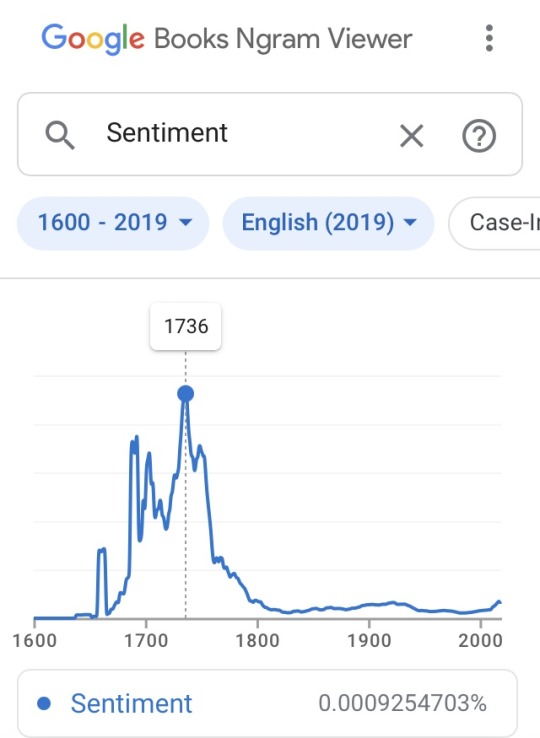

Would you look at that, it’s the same pattern again!!
And just to prove this isn’t the nature of Google Ngram, but actually something significant, let’s look at soirée!

The opposite of our pattern so far!
While, I’m not saying this is the most factually sound, I am saying Mad Dog’s preferred literature is from the 1700s and no one can change my mind on this.
For those of you who know books better than me (and read all of this?? Hi) if you have any ideas as to specific books he probably read and enjoyed and let shape his personality…please oh please tell me, I’ll give you a little virtual kiss on the cheek if you do.
Anyway this is my research?? On their chapter so far. If you read all of this thank you!! Now I know you’re just obsessed with these cowboys as I am. And if you have any questions or anything to add please feel free to let me know!!
37 notes
·
View notes
Text
I’ve found that I enjoy monster aus and fantasy type settings more and more lately and I’ve been slightly inspired.
Some context first that this is by all accounts a mish mash of different ideas in every single way, I had some old OCs I wanted to revamp and I decided I wanted them to be monsters while putting a fun twist on the usual stuff. Secondary context is that I’m a huge Science nerd and I enjoy reading species studies in that textbook style description so when talking specifically about certain species/races I often use that manner of speaking a bit. Latin, Greek, and Old English are also very prevalent influences in how I go about naming things haha.
I’ve taken to calling this universe ‘Rigor Mortis’ to remind myself that I want there to absolutely be uncanny and eerie elements along with some mildly wholesome ideas. I also just think it’s sounds cool 😎 Pardon me if this is all a lil messy and all over the place 😞
Rigor Mortis is a universe in which the veritable “monsters” of mythology, folklore, and the like are very real and are just as old and prevalent as humankind. Humans of course referred to these creatures as “monsters” for a very long time and though of course there is actual names they have given their kinds the term continued to stick horrendously and the official term is Monstrum when speaking in vagueness of the inhuman.
That being said the power struggle between humankind and monstrum is quite literally ancient. With a variety of Holy Wars being raged as well as retaliatory conquests plaguing the planets history throughout the continents. Eventually though a ceasefire and shaky peace was achieved only barely in the last few decades with multiple civil disputes and arguments of rights for either side still occurring until now. (I wanna say circa the late 1890s early 1900s is about when things get politically stable)
The climate of the interpersonal relationships between humans varies from country to country and can be extreme in its differences. Some countries are responsible for industries like human farms, specialty construction/tailoring, and synthetic nutrition . Simply for the reasons that while there is peace in one particular country it doesn’t change the fact that some monstrum do still require a diet that involves human consumption thus why synthetic means are also being developed, monstrum can also come in such vastly different shapes and sizes there is no way to maintain a standard for ANYTHING so practically everything one owns often is or needs to get specialized.
Humans despite what you may think, are not the majority of the population! In fact Humans are more of a minority (for a multitude of reasons) that only make up about 40% of the planet’s population which does include those contained in the aforementioned farms. Which is not to say that there are not humanoid looking variants of monstrum, the 40% statistic applies to full blooded humans. The numbers having seriously lowered after a boom in monstrum population 😅
Ironically humans, as hilarious as it was to find out after a time, are like O- of the reproductive world of monstrum. They can mix seamlessly with any race of them and the offspring retain a majority of the inhuman traits and very little human ones, a real purists dream. Thus some upper class monstrum who like to stress bloodlines and retain their traits can often pay extensively good money for human aid (willing participants or not) but this fact is also attributed to the influx in monstrum population as more and more cases of interbreeding became slightly more common. To be perfectly honest however humans are largely more common to be fetishized by monstrum than seeking anything romantic
On the subject of reproduction, monstrum are perfectly capable of reproducing within themselves to a degree. These mixed offspring however end up with a strong mixture of both parents and can make for some interesting looking individuals. If a monstrum has fairly mixed heritage, of over 3 specific races, then they’re considered Chimeric! Chimeras themselves don’t fall under the statistics of multiple categories and instead are classified both medically and governmentally by their most prominent race. (Obviously an insectoid can’t reproduce with a lycanthrope or fish person normally, however cases of this and similar situations can be plausible if the parents have just enough human genes to bridge the gap. These individuals are incredibly uncommon but they do exist, as retention of human genes is enormously recessive and take generations of consistent reproduction with humans to acquire them.)
Aside from the 40% of pure humans the remainder 60% of monstrum can be broken down into multiple subsidiary categories. They can be classified based on either the same genus, family, or species classification we may give animals or by specific traits they have in common. (i.e. diet, specific physical features, environment..) but ‘genus’ is the most popular way of classification.
I know I have literally zero followers so nobody else is probably going to read this but me, but I’ve had this sort of open project idea for awhile and figure that here is as good a place as any to write down what I have so far of this universe premise. More posts to come as well detailing actual species/race details
….eventually. Maybe. At some point. If I actually remember to 🥲
#monster#creature#monster au#alternate universe#ish#work in progress#nobody’s gonna see this heehee#everything here is subject to change#I’m developing this universe little by little on my own#there’s so much#oof 😮💨#Rigor Mortis
0 notes
Text
with the announcement of the great ace attorney i'd like to ask that everyone please refrain from creating or engaging with art that has the rising sun design on it.
tl;dr: it symbolizes the glorification of japanese imperialism so using it sucks.
not tl;dr, everything below the read more.
(tws for below include: discussion of colonization and imperialism, multiple examples of the rising sun motif being used)

(img: the current japanese flag. a white background with a red circle in the center)
this is the japanese flag used today. it’s different from what i’m about to talk about -- this one’s fine, it’s just a flag!
(edit: i put this image as the first one because i got sick of seeing rising sun flag in my notifs)

img: a red circle with alternating red and white stripes coming from the center. sometimes the white stripes are yellow or another pale color, but the design is very distinct.
i’m talking about this flag. for those who don't know, the rising sun motif is a common symbol in a lot of japanese art and design. its motifs (those red and white (sometimes pale yellow) alternating rays) show up quite a lot in anime, games, and decorations around and from japan. they shouldn’t.
nowadays, the rising sun carries a storied and extremely bloody history. to the nations and people japan invaded, it symbolizes that colonization and the numerous war crimes that japanese soldiers and government committed. i don’t really want to get into it so google "japanese imperial war crimes" if you don't already know. they were an empire. they colonized. you can probably guess the rest.
the japanese government still refuses to take accountability for their crimes, and even goes as far as to deny they ever happened. no apologies have been issued, ever, and even some japanese textbooks refuse to even acknowledge the subject. (this article’s from 2013 but it’s still applicable.)
so using it as a decorative element in your artwork, as you might guess, raises some issues. it would be like hanging a confederate flag as aesthetic flair at your american diner (and i know some places do that. they shouldn’t.)

(img: two screencaps from persona 5. on the left, the original version, where ryuji’s shoes have the rising sun emblem embroidered on the side. on the right, the version released in korea, where the shoe is white.)

(img: a logo for a japanese import store. a box with the rising sun logo on its side.)
unfortunately, lots of things do just that! these two were literally just stuff i pulled from my memory in two minutes. but it sucks! you shouldn’t do it!
"but how does this relate to lawyer game?"
the rising sun has appeared multiple times in promotional art or merchandise for dgs as decoration, which is a careless and harmful move on the part of the artists and of capcom itself.
the rising sun did exist before the 1900s, so having it on dgs art (roughly the 1890s) is technically historically compliant, but it turns out that meanings change over time, and sometimes, when you depict something from the past it carries new meanings in today’s context!
these games might be set in the past, but they are extremely modern creations. they shouldn't have this motif, and neither should any fanart.
the rising sun not just a decoration anymore, and it hasn’t been for over a century. symbols have meanings, and those meanings can change over time with context. what matters is what the rising sun symbolizes now.

(img: art released for dgs’ 5th anniversary depicting asougi and ryuunosuke. asougi has one arm wrapped around naruhodou and is smiling. naruhodou is smiling, with his left arm raised to the viewer. the background is decorated with the red and white stripes of the rising sun motif)

(img: an officially licensed coaster depicting ryuunosuke. the coaster background has red and white stripes emanating from ryuunosuke, in a flag pattern of the rising sun.)
at best, the rising sun is a symbol of refusal to acknowledge japan's imperial past, and at worst a glorification of it. right wing japanese media loves the rising sun flag almost as much as they like to deny all the war crimes.
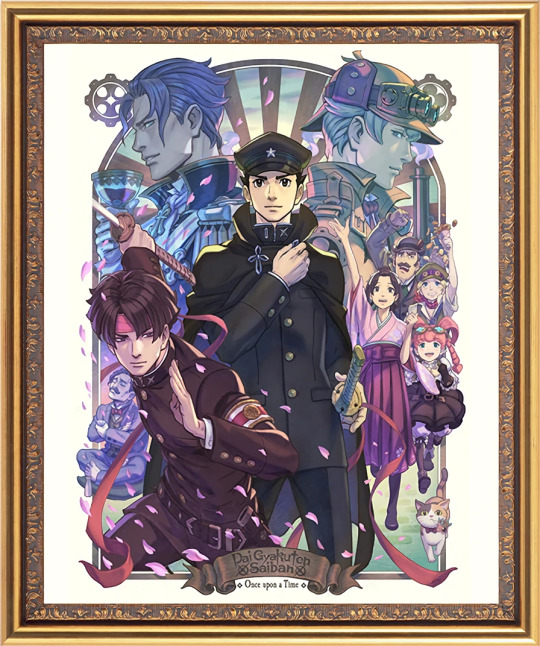
(img: promotional art released for the 15th anniversary of ace attorney. it features the dgs cast, naruhodou as the center, with the rising sun motif as the background)

(img: promotional art for dgs, depicting a chibi ryuunosuke surrounded by chibi heads of some of the rest of the cast. he’s holding one arm up to the camera, smiling, with the rising sun motif decorating the background.)
dgs is a product of the culture that created it. and it is literally set right before japan decided to go full steam ahead on brutal colonization, so "an empire with no justice has no future" rings a little hollow knowing what comes after. (japan was being exploited at the time, but right after they decided to do the same exact thing...)
i'm not expecting a thorough critique of imperialism in my fun steampunk sherlock holmes crossover romp, and as wild as "dai gyakuten saiban 3: ryuunosuke naruhodou dodges the draft" would be, capcom would never make a game like that.
there’s a lot to be discussed regarding dgs’ critique of imperialist power and of how japan in the late 1800s was entering that militarized colonizing state and how it’s criticized, but i am not the person to be making that post.
EDIT: this tweet thread is more on that
anyway.

(img: an officially licensed phone case depicting ryuunosuke and asougi, with the rising sun motif in the background.)
at the very least you can't deny it is at least, a little weird seeing imperialist symbols plastered on top of merchandise.
i don’t hold any sway over capcom or the people who make ace attorney. but what i do ask if that people who like these games or want to show their appreciation (like me! i draw fanart of it sometimes!) just don’t put the rising sun motif on it. basically, just don’t put it on your art?? that’s literally all i’m asking.
thanks for reading all this also this is applicable to any decorative use of the rising sun motif like persona 5 or demon slayer or whatever. enjoy your sholmes when the game is released i probably will
3K notes
·
View notes
Text
Beware Of Massive Nightgowns, Part II: Lucille and Comparison
Part 1
So, I've already done a bit of analysis on Lucille's robe and nightgown vis a vis the Aesthetic Dress/Artistic Reform movement of the 1890s-early 1900s. Here is that post for background. But in summary: her robe in particular reflects a niche trend at the time for loose, unstructured tea gowns that drew inspiration from elements of Italian Renaissance clothing.

(Lucille's robe and nightgown. Finding good full-length still shots of this costume is HARD. But I think this one gives a decent impression of what's going on.)
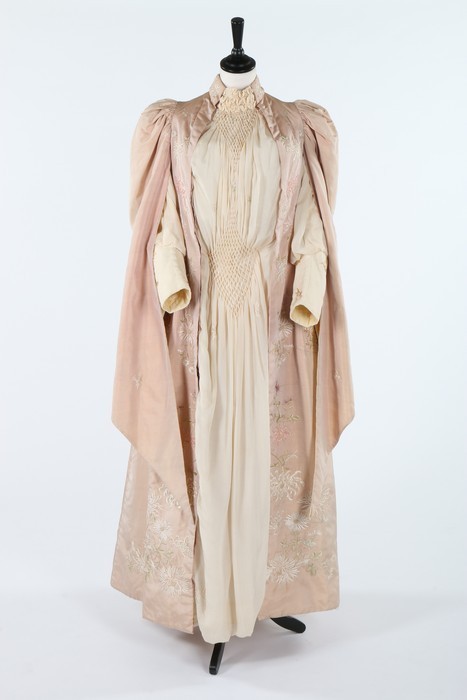
(Tea gown c. 1890. Kerry Taylor Auctions. I wanted to pick an image I hadn't shared before, and the split sleeves seemed very Murder Robe-esque. This one doesn't have the watteau back, but the ones I shared in the previous post did.)
Once again, there's very little resemblance to anything really worn for sleeping or lounging in the actual eras of her adulthood. Or her mother's, for that matter. Like Edith's nightgown, it seems to be a blending of historical trends from different types of clothing to best help convey things about the character in those moments. Which...yeah, that's exactly what costuming period film is. And if done correctly, you end up with something lush and artistic that's still grounded in historical reality.
I just. I really love these costumes, guys.
Interestingly, I've found some Victwardian nightgowns that do look a bit more sheer and/or low-cut:
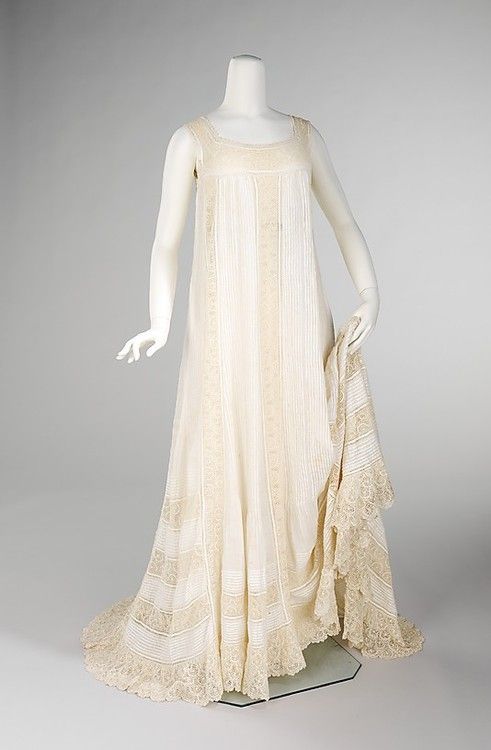
(Nightgown, c. 1905. Met Museum.)
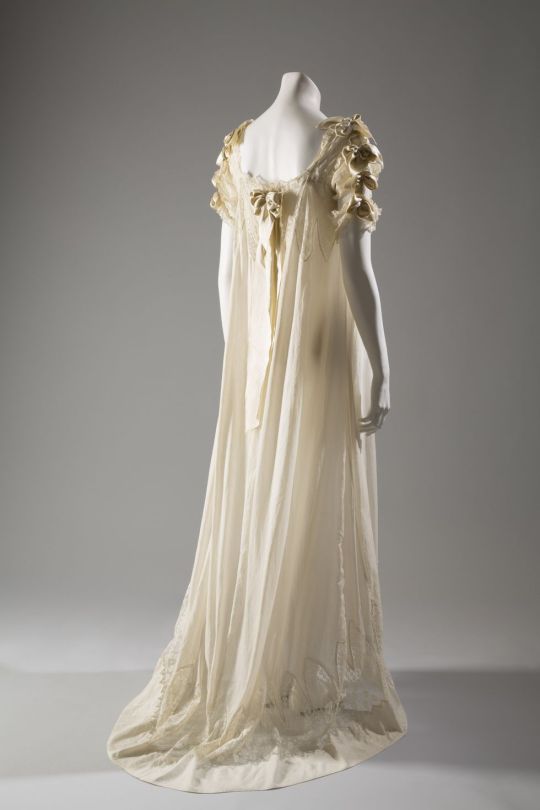
(Nightgown c. 1900. FIT Museum. Elle.com says this was part of a bridal trousseau, and that was a common context for more revealing nightwear. I'm not sure I trust their research standards, but that does fit with my theory that the Murder Nightgown is Lucille's sexy lingerie if it's true. Warrants further investigation.)
Which goes along with the idea that the robe/nightgown set is the most "modern" outfit we ever see Lucille in. All the historical callbacks are from the 1890s-early 1900s, decades after her usual Natural Form day gowns. And yet, as I said before, they're revival styles from those eras. Simultaneously the newest looks we've seen on the character, and the oldest clothing influences in the entire movie.
As the costumer said repeatedly, this outfit represents the gloves- or rather, corset -coming off for Lucille. She's not holding anything back, and the full depth of her...Whole Deal is on display. It also reflects the Gothic Revival architecture of the house even more completely than her daywear. There's very little of the 19th or early 20th century left in her visually at this point- she IS the house, and they are both creatures of the past. If Edith's nightgown represents her leaving her familiar world behind, Lucille's shows that she's completely in her element.
I also feel like Edith's nightgown makes her look younger and more vulnerable, while Lucille's doesn't really have that effect. Kate Hawley mentioned that they had multiple versions of Edith's nightgown with different sleeve sizes, to make her look smaller and more overwhelmed as the plot takes its toll on her.
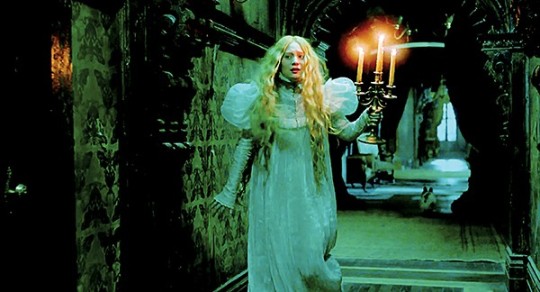
(Probably helped by the fact that you see her wear an almost identical nightgown as a child, and then a much more subdued one as an adult in Buffalo.)
Lucille, on the other hand, has all the volume lower down on her sleeves and the hems of her nightgown and robe, which to me makes her look even more imposing. They're also relatively sleek-looking garments, especially when they're not in motion- streamlined volume to Edith's huge puffed sleeves and ruffles.
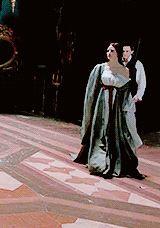
(GIF by @anneboleyns. Seriously, stills of this ensemble full-view are impossible to find.)
Also note that her hair, while more Down than we've ever seen it before, is still at least braided in these scenes while Edith's is completely unbound. Which I feel sort of adds to the visual of her as predator and Edith as prey.
Tangent: This movie uses women's hairstyles for storytelling in a really effective way- note that Edith's hair is even up during the sex scene, underscoring that as a moment of confidence, maturity, and control for her. You can do cool things like that when you're not allergic to hairpins, Hollywood! WHAT A CONCEPT.
In conclusion, both nightgowns are fascinating to explore vis a vis actual history, and do a wonderful job of combining period reality with artistic storytelling. But that's true of basically all the costumes in this movie, so. Yeah.
Which one do you like better? They're both gorgeous, but I'd love to hear how many people are Team Butterfly vs. Team Murder Sleeves!
#crimson peak#gifs#long post#costumes#costuming#historical costuming#movie costuming#lucille sharpe#edith cushing
219 notes
·
View notes
Text
Timeline of Middle-Earth
To develop a clearer sense of the sheer scale of the timelines we’re dealing with in Middle-earth’s Ages of the Sun, I thought I would put it in perspective by comparing it to real-world history. This can be done comparatively simply because the main events of The Lord of the Ring occur in 3018-3019 BC. (3020 in Middle-earth is a very good year, conspicuously unlike our 2020.)
So if we analogize T.A. 3019 to our 2019, we can get a sense in our terms of how long ago various Middle-earth events were to (mortal) characters in The Lord of the Rings. The beginning of the Third Age, for example, would line up with 1000 BC (approximately the time of Solomon). The beginning of the Second Age would be 4441 BC, and the beginning of the (much shorter) First Age a little before 5000 BC. A lot of my dates will be from the history of the Ancient Near East and Europe, simply because those are the periods of ancient history I’m most familiar with.
Using this comparison, the beginning of the Second Age and the foundation of Númenor is roughly contemporary with the earliest development of the wheel (~4500 BC, Wikipedia tells me) and the earliest forms of writing. So if you want a timescale for just how old any elf who saw the First Age was, that’s a helpful starting point (Maglor and Galadriel are, of course, much older).
The forging of the One Ring (c. S.A. 1600) corresponds to a little before the construction of the Great Pyramid of Giza.
The imperialist era of Númenor, under Tar-Ciryatan, begins at about the same time as the building of the Great Pyramid of Giza (~2500 BC) and lasts until roughly the end of the New Kingdom of Egypt (that’s the one that included Hatshepsut and Ramses II) a little before 1000 BC. That makes ancient Egypt really quite helpful for envisioning the span of Númenor’s history, except that Númenor also had about 1900 years of being non-terrible prior to that.
The Last Alliance of Elves and Men corresponds to around 1000 BC, around the tine of the start of the Chinese Zhou dynasty (for context, this is still well before Qin Shi Huang and the Terra-Cotta Army) and the time of David and Solomon in ancient Israel.
Arwen is born in the year 241 of the Third Age. This roughly corresponds to the time of the composition of the Iliad and Odyssey by Homer. So when Elrond tells Aragorn that Arwen is far, far older than him, he is, if anything, understating the point.
The breakup of Arnor into three realms occurs in T.A. 861. We have now skipped over a quite considerable period of time (past the Assyrians, Babylonians, and Alexander the Great in the ancient near east, andpast Qin Shi Huang in China) to the time of the Roman Republic and of the Han dynasty. So that gives some perspective on what Aragorn re-founding the kindom of Arnor means - the the people of, say, Bree, this is a kingdom from ancient history.
Around T.A. 1000 - corresponding to the time of the New Testament and the early Roman Empire - the Istari arrive in Middle-earth and the first hobbits come to Eriador (i.e. the land west of the Misty Mountains). However, the hobbits don’t cross the Brandywine and found the Shire until a long time later (T.A. 1600).
The centuries around T.A. 1300s-1400s see civil war in Arnor (incited by the Witch-king of Angmar) and Gondor, and in invasion of Arnor by the Witch-king. This corresponds to around A.D. 300s-400s in our time, and the fall of the Roman Empire.
The Shire is founded in T.A. 1601, corresponding to around our A.D. 600. This is roughly equivalent the time of the founding of Islam in our world. So the Shire’s got a very considerable history behind it!
The fall of the north-kingdom of Arnor to the Witch-king occurred in T.A. 1974. Also in the late 1900s of the Third Age, the Witch-king returns to Mordor; a Balrog appears in Moria and drives out the dwarves; and Thrain I founds the Kingdom Under the Mountain in Erebor. A little after (T.A. 2050) the line of the kings in Gondor ends and the time of the Stewards begins. This is equivalent, in our terms, to around the time of the Norman Conquest of England, and of Cahokia in North America. When Boromir asks his father why the Stewards of Gondor are not considered kings yet, he has a point.
In 2463, the White Council is formed; this is also around the same time that Gollum obtains the Ring. Roughly speaking, this is equivalent to the time of the Renaissance in Europe for us. Gollum had the Ring for a really freaking long time.
The arrival of the Rohirrim, and the granting of Calenardhon to them as the realm of Rohan (irrespective of its actual inhabitants) occurs in 2510 of the Third Age, or close to equivalent with the beginning of the Reformation for us.
The Bagginses, Tooks, and Brandybucks can trace their ancestry back to the years 1000s to 1100s in Shure-reckoning (2600s-2700s of the Third Age), equivalent to a family in our time being able to trace its lineage to the 1600s-1700s A.D.
Smaug’s destruction of the Kingdom under the Mountain is in T.A. 2770, shortly followed by the War of the Dwarves and Orcs when Thror (Thorin’s grandfather) is killed by an orc in Moria. In our terms, corresponding to 1770, around the time of the American Revolution. Thorin dies in T.A. 2941 (equiv. A.D. 1941), to to get a perspective on dwarf ages, Thorin’s lifespan is equivalent to someone being able to fight in both the American Revolution and World War II.
Bilbo is born in T.A. 2890, equivalent to 1890 (the Gilded Age) in our time. The Fell Winter, when wolves attack the Shire over the frozen Brandywine, happens when he is 10 years old.
Aragorn and Denethor are born at almost the same time, Denethor in T.A. 2930 and Aragorn in T.A. 2931. Huh, hadn’t realized that. How mich does Denethor resent that he’s an old man while Aragorn is still in the prime of his life. Anyway, this is around the 1930s in our terms.
The events of the Hobbit take place in T.A. 2941, equivalent to our 1941 - a happier year for Middle-earth than for us, certainly.
Frodo is born in 2968, equivalent to our 1968.
Bilbo’s eleventy-first birthday, and the events of The Lord of the Rings, occurs in T.A. 3001, equivalent to our 2001.
So, hopefully that gives some perspective on how long ago the various events of Middle-earth’s history would feel to the mortal - or at least, human and hobbit - characters of The Lord of the Rings. The major difference is that the existence of elves mean that both written records and living memory go back far, far further for Middle-earth than they do for us.
485 notes
·
View notes
Note
Might I please jump in with the suggestion that, while making Superman a Pulp Hero can be a little tricky, making LEX LUTHOR a Pulp Hero would be peculiarly easy? (In fact making him a Pulp Hero without making major alterations to his fundamental character might be far more difficult - given how much of a self centred jerk the man is).
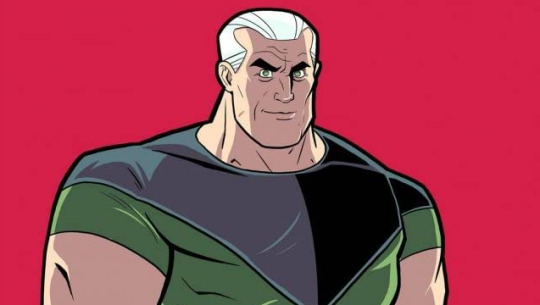
Funny you mention that because, while I haven't read the comic enough to really speak much of it, that kinda seems to be the basic premise of Chris Roberson's Edison Rex, a comic about a supervillain who has to step in as Earth's protector after defeating his superhero enemy, with the titular character being a Lex Luthor-analogue who looks like Doc Savage with Thomas Edison's haircut.
In fact, the idea of Thomas Edison as a protagonist is not even a unique one, not when one of the earliest examples of dime novel sci-fi was named after him. Just as popular in it's heyday and irredeemably reprehensible as the man itself even. If you want to imagine how Lex Luthor looks like as a pulp hero, all you need is to look at the genre called "Edisonade", starting in the 1870s, and you'll see why you wouldn't even need to make that many substantial changes to Luthor's fundamental character if you were to try to pass him off as a dime novel sci-fi protagonist. Not just because pulp supervillains already starred in stories and magazines as is, but because Edisonade as a genre is already built to accomodate characters like him.
The term "edisonade" or "Edisonade" – which is derived from Thomas Alva Edison in the same way that "Robinsonade" is derived from the hero of Daniel Defoe's Robinson Crusoe – can be understood to describe any story dating from the late nineteenth century onward and featuring a young US male inventor hero who ingeniously extricates himself from tight spots and who, by so doing, saves himself from defeat and corruption, and his friends and nation from foreign oppressors.
The Invention by which he typically accomplishes this feat is not, however, simply a Weapon, though it will almost certainly prove to be invincible against the foe, and may also make the hero's fortune; it is also a means of Transportation – for the edisonade is not only about saving the country (or planet) through personal spunk and native wit, it is also about lighting out for the Territory.
Afterwards, once the hero has penetrated that virgin strand, he will find yet a further use for his invention: it will serve as a certificate of ownership, for the new Territory will probably be "empty" except for "natives". Magically, the barefoot boy with cheek of tan will discover that he has been made CEO of a compliant world; for a a revelatory set of maxims can be discerned fuelling the entrepreneurial engine of the edisonade: the conviction that to fix is to patent: that to exploit is to own - Sci-Fi Encyclopedia's entry on Edisonade
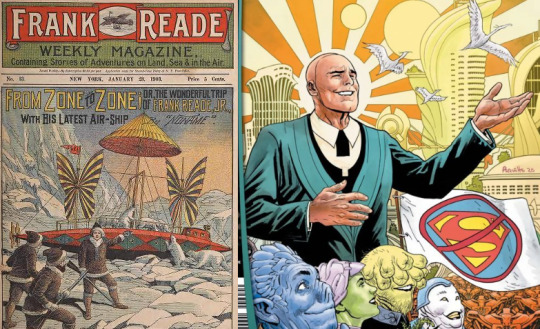
The Edisonade, coined by critic John Clute after the Robinsonade, can be defined simply enough: it is a story in which a young American male invents a form of transportation and uses it to travel to uncivilized parts of America or the world, enriches himself, and punishes the enemies of the United States, whether domestic (Native Americans) or foreign.
The Edisonades were almost entirely an American creation and appeared in dime novels as serials and as complete novels. They were the single largest category of dime novel science fiction and were the direct ancestors not only of 20th century boys’ fiction characters like Tom Swift but also one of the fathers of early 20th century science fiction, especially in the pulps. And the Edisonades were among the most morally reprehensible works of fiction of the 19th century, on a par with the dime novels the Confederacy published to glorify slavery - Jess Nevins's article on Tom Edison Jr
Fun for the whole family!
Granted (and thankfully), Edisonades as a specific genre died down in popularity following the end of dime novel, although you can very easily see how their influence lingered on much of sci-fi as we know it. It makes for a rather interesting coincidence even that, in the turn of the century, as the dime novels and the Edisonades died down in popularity and the pulp magazines proper started to take their place in American culture, the Mad Scientist began to arise in popularity as a stock villain to the point you can make a drinking game out of reading pulp novels where the kind professor with a weird invention turns out to be a cut-throat master villain.
The Mad Scientist as an archetype, which is what Luthor started as, actually seems pretty much non-existant prior to the 1890s (the term seems to have only caught on somewhere after 1893 following the World's Fair Columbian Exposition) and only really started taking shape in the 1900/1910s following the influence of German Expressionism villains and characters like Fu Manchu (far from the first yellow peril mad scientist, but definitely the most popular) and the myriad of pulp villain, even pulp villain magazines, named after some form of "Doctor" (Doctor Death, Doctor Satan, Doctor X, etc)
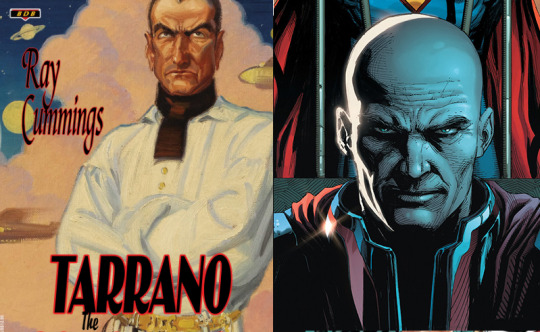
I'm not particularly fond of Arch-Capitalist Luthor and I'm not gonna be the billionth guy online to talk about the relevance of that take on Luthor, because my preferred take on Luthor is more on the Emperor Scientist / Ubermensch Arch-Asshole, the kind that's not so much a stock villain archetype because he doesn't have to be, because "Lex Luthor" has practically become it's own archetype, you know it when you see it. I would prefer to emphasize a Luthor who's got more in common with pulp sci-fi supervillains who starred in their own stories, but the stories themselves had no delusions about what the characters were. And I think Luthor can make one hell of a protagonist in this regard.
In another place, under different circumstances, this man might have been a Caesar, a Napoleon, a Hitler, or an Archimedes, a Michelangelo, a da Vinci. A Gautama, a Hammurabi, Gandhi. But in this place, at this time, he was more. Superman made him more.
As an artist saw objects as an amalgam of shapes, as a writer looked upon life as a series of incidents from which plots and characters could be constructed, Lex Luthor's mind divided the Universe into a finite number of mathematical units.
The time he had spent in jail so far this year was three months of thirty days each, three weeks, six days, two hours, and sixteen minutes. This included four weeks, one day, and three hours in solitary confinement during which time he could do nothing more useful than count seconds and scrupulously retain his sanity.
There were other super-criminal geniuses in the world; he had met some of them, dealt with them on occasion. They were chairmen of great corporations, grand masters of martial arts disciplines, heads of departments in executive branches of governments, princes, presidents, prelates, and a saint or two. Unlike Luthor, these men and women chose to retain their respectability. They had trouble coping with honesty.
Luthor was not motivated by a desire for money, or power, or beautiful women, or even freedom. In solitary Luthor decided that his motivation was beyond even the love or hate or whatever it was he had for humanity. It was consuming desire for godhood, fired by the unreasonable conviction that such a thing was somehow possible.
He began by being an honest man. He was a criminal and said so. - The Last Son of Krypton, Chapter 12
#replies tag#dc comics#lex luthor#superman#elliot s maggin#last son of krypton#tarrano the conqueror#pulp supervillains
34 notes
·
View notes
Text
Engport Thoughts:
Warnings: this ain’t fancy sh/t ok it’s just the stuff I yell in my own head at 4 AM and its hella long too
I don’t really vibe with the view that engport’s power dynamic is skewed in Arthur’s favour, and that Port somehow loves Arthur more than Arthur loves him. Yes, Port has his moments of doubt, and yes, politically speaking for the past two centuries England’s been more powerful and relevant on the world stage. But nowadays they’re not that different, and while Port did harbour some serious resentment in the 1800-1900s because he felt that Arthur wasn’t treating him like an equal, in the century they spent apart I think he realized how much of that feeling came from his own self-hatred and fears rather than Arthur’s actions.
Like yes, there was the period after Napoleon where England controlled Port’s affairs for a while, and ofc there was the ultimatum — but is the ultimatums importance not sometimes overstated? Even for its time it was a pretty minor disagreement with little political fallout. To me, the ultimatum is only important as the last straw that broke the camel's back—since the decline of the Portuguese empire began, slowly at first and more noticeably after 1800, Ports own worries and anger and fear grew, often exacerbated by comparisons with England. Arthur noticed, but could do nothing about it; he couldn’t well have sacrificed British interests to assuage Ports nebulous feeling of inadequacy, and even if he had Port would only have seen it as pity. In fact Arthur didn’t know how to deal with it at all, so he said nothing. It’s that feeling when a friend or loved one says to you “I don’t deserve you” (as a way of saying “I’m not good enough”, not “you’re really great”) -- how is one supposed to respond? As a nation and a man Portugal needed to redefine the source of his own value, and that wasn’t something Arthur could do for him.
Of course Arthur may not have made this process any easier; in the best of times Arthur is about as good at communicating complex and tangled emotions as a sea cucumber, and when you add in the growing ambition of the British people and the daily European squabbles and power shifts, it all becomes a mess. I honestly think Arthur probably made the best choice available to him by not addressing it in the 19th century — if he had tried, his abrasiveness and Ports extreme sensitivity on this issue would surely have blown up their relationship sooner than 1890. To illustrate the point that this wasn’t a “Arthur treats Gabi as an inferior” issue, consider if England had briefly directed French policy like they did Portuguese after the Napoleonic Wars. Francis would of course start squawking up a storm, but I don’t think Francis would feel like him and Arthur were no longer equals. France in fact went through a similar experience as Portugal but hyperspeed from 1940-1950 where they had to confront going from Great Power to “stfu ur only on this council cuz the US is in a good mood.” But Arthur and Francis had a stable relationship during this time, because Francis’s identity and self worth (as a man, not a nation) is less rigid and based upon “providing for others” and “being Europe’s sole supply of shiny and yummy things” than Port's was.
So yeah, my point is that Arthur treated Gabi in the 1800s like he had always treated him — and even being extra careful not to aggravate his insecurities. It was Gabriel that felt more and more inadequate, irrelevant, powerless, so that when an issue comes along like the Pink Map; boom, you got urself a self-esteem issue bath bomb. Note that I’m talking about Artie and Gabi's personal interactions, NOT England’s diplomatic treatment of Portugal. Of course as states England recognized Portugal's diminishing relevance -- if they didn't, that would mean the English foreign office was bad at their job. And Gabriel was certainly intelligent and experienced enough to appreciate this distinction between interpersonal and international relationships, which is also why Gabi didn’t seek an argument with Arthur before 1890, either. He knew it wasn’t Arthur’s fault that he felt the way he did, but the humiliation of the ultimatum hit too close to home and he exploded anyways.
One last thought about their power dynamic: on an emotional level, I feel like Gabi has more cards to play than Arthur. Gabi holds so much sway over Arthur’s emotional well-being that I often think about how bad it could get if Gabriel chose to abuse that power. Arthur himself has so many insecurities and traumas that it would be so easy for Gabi, who knows him so well, to exploit them, especially when Arthur’s pretty much been hardwired after 9 centuries to trust Gabi. I think Arthur’s logic goes something like, if I can’t trust Gabriel than theres truly no one in this world I can rely on, which makes it, uh, really easy for Gabi to gaslight him. Like, if he just said “no one will ever love you but me,” Artie would believe that shit. He’d be on guard if it came from anyone else, but if Gabi says it mf would f/in internalize it. “If you leave me you’ll be alone,” “no one can forgive you for what you’ve done, but I will,” “if you died no one will give a shit but me.” These are all things Arthur half believes already, so it’d be a piece of cake for someone as astute as Gabriel to push him over the edge (@needcake has a great fic here about dark!engport which explores this abuse of trust). I think Port is actually very aware of this and goes out of his way to avoid saying things like that, precisely because he knows how fragile Arthur’s mental health is and how much he needs to trust Gabi. Sometimes this can be a burden on Port, too, which results in him softening his stance or giving in when he should draw a clearer line because he’s scared he’ll aggravate Arthur's insecurities.
TLDR; PORT'S PROBLEMS ARE NOT ALL MADE IN ENGLAND, PORTUGAL HAS ITS OWN DOMESTIC INDUSTRY FOR MANUFACTURING ISSUES™, and they’re actually very soft on each other and careful with each other’s feelings. They’re trying so hard, but history doesn’t give out medals for effort.
#engport#hws england#hws portugal#my hcs#when i was doing research for the dark world is not far from us#i read some speeches given in the House about the importance of anglo-portuguese relations#i can't recall if it was turn of the 20th century or during ww2#but they basically talked about port's strategic importance to England as a check for Spain#as well as Port's historical loyalty to and sincere treatment of England#so yeah this whole long ass post is basically ab that and how port aint some starry eyed victim of his own terrible affection#he's a grown ass man for goodness sake#lets not make their relationship that one dimensional
67 notes
·
View notes
Text
Historical Simblr Tag Game
Thank you @applesaucesims for tagging me!
I think most people I follow have already been tagged, so I’m tagging anyone who’s interested!
Long post under the cut.
1. What has been your favorite time period to play in or which one are you most excited for?
For my TS3 Decades Challenge, I really enjoyed the 1930s and 1950s. I had a lot of fun with storytelling during those decades.
For my current TS4 Decades Challenge, I'm looking forward to the 1900s (because I already have a lot of plans for my 1890s kids and I'm looking forward to writing their stories), the 1930s (because I really like 30s fashion), and the 1910s and 1940s (because I enjoy making my Sims and my followers suffer).
2. Do you have a favorite piece of historical cc? (CAS or BB)
I have so many, but I’m only going to list a few here.
I love these vintage wallpapers and wall art - they really make my historical Sims’ houses feel more historical!
I also love basically everything by @/happylifesims, even though I haven’t had a chance to use much of their CC in my current story yet.
3. Who is your favorite sim currently?
It’s hard to choose just one, but right now, I love Alice Warren from my TS4 Decades Challenge! I’ve had a lot of fun writing her character so far, and I’m looking forward to writing the rest of her story. (Honestly, though, I love all of my 1890s kids so much!)
Another one of my favourite Sims is Edna Robinson from my TS3 Decades Challenge! She reminds me of myself in some ways, and I really enjoyed writing her story. She’s also one of the main reasons why I enjoyed the 1930s and 1950s so much in that story.
4. What is your favorite world?
Henford-on-Bagley! It’s an absolutely beautiful world, and I love farm gameplay and the whole cottagecore aesthetic so of course I’m gonna love it. (Plus it was inspired by England, where I’m from!)
5. Are you more gameplay or story focused?
Definitely more story-focused, but I do try to incorporate some aspects of gameplay into my story.
6. Do you like to play with pets in your historical saves?
I’m not sure why, but I don’t tend to play with pets in general, at least not in TS4. In TS3 I used to play wih pets all the time, but I didn’t really like the fact that pets weren’t controllable in TS4.
7. What’s your biggest immersion breaking pet peeve with the game?
Phones. I hate it when I’m playing a historical save and my Sims just randomly start browsing the web or playing games on their phones.
8. What’s your favorite in-game historical item? (CAS or BB)
Most of the Cottage Living kitchen stuff is great for historical gameplay. Also the base game wood-burning stove is very useful.
9. What would you like to see as a new pack or asset to the game?
I’d love a whole pack dedicated to historical stuff from different eras. I know Get Famous and Cottage Living already added some historical-ish stuff, but I’d always like to see more!
I also would like to be able to save custom styled looks in CAS. That would be really useful.
10. What pack do you think is invaluable as a historical simmer?
Again, Cottage Living, for reasons I’ve already mentioned. If you couldn’t tell already, I love that pack.
Get Together is also very useful, because it has Windenburg and some useful BB items. I also like Discover University, because Britechester is a good world for historical (mainly Victorian/Edwardian) storytelling and gameplay.
11. Do you have a favorite mod to enhance historical gameplay?
I haven’t used it in my Decades Challenge, but I really like Ye Olde Cookbook. I used to do a lot of medieval gameplay in my own time before I joined Simblr, so I used that a lot. It also comes with loads of other things that are really useful for historical gameplay!
12. What’s your ideal family size for playing?
I like to have between 4-6 Sims in my household. Big enough to not be boring, but small enough so I can focus on each individual Sim and write their story.
13. Do you use poses?
All the time! Poses are really useful for storytelling.
14. Do you use any overrides in your game?
I use this default skin for all my Sims, and a mod that replaces the modern mop that Sims use to clean up puddles with a broom.
15. Do you, or did you, play off-the-grid during your game?
Nope. I tried it, but it didn’t enhance my gameplay at all - it was just an annoyance. Also, my Sims couldn’t cook almost anything, which was both annoying and historically inaccurate.
Instead, I just try to keep everything as historically accurate as possible - using old-looking lights, baths instead of showers, old-fashioned toilets etc.
16. What lifespan do you play on?
Always normal. I don’t like my generations to drag on for too long, and I don’t want them to be too short either.
17. What inspired you to start playing a historically?
I think I’ve always liked historical fashion, so I downloaded a bunch of CC and started making historical Sims with it.
What inspired me to start my first Decades Challenge, though, was when I was looking back through my own family tree. I just thought “What if I made historical Sims and played with their family up until modern times?” Then I found the actual Decades Challenge rules and found out that people were already doing that, so I started doing it myself.
I was just going to play on my own without writing a story or anything, but then I started reading other people’s stories on Tumblr and got some inspiration, so here I am now!
14 notes
·
View notes
Text
Things I’ve learned self drafting clothing.
I’m mostly sewing 1900 - 1917 ish Edwardian clothing. I’ve done a couple of skirt patterns, a vest pattern, a coat, a shirt, and experimented with some others. Outside of that, I’ve done a copy of a commercial piece of clothing, and some commercial patterns.
Lesson 1: Have something that fits you as a sanity check. A lot of Victorian / Edwardian clothes assume you’re wearing a corset and that you’re padding your figure. A corset tends to have your shoulders farther back, which changes the shoulders in relation to clothing. Edwardian clothing also tended to have high narrow collars hiding the neck. A sanity check of a shirt / pattern that you know fits your shoulders, neck, and armholes can be good.
Modern clothing tends to have very big armholes and neck openings, so some variance is totally normal. When I drafted Laura Baldt’s shirt waist, I checked the pattern against my 1890′s vest pattern. As written, the shoulders seemed too short, and the neckline seemed too tight. I slightly opened the neckline and adjusted the curve, and lengthened the shoulders by about 1 1/2 inches. The finished shirt was too long in the shoulders (by about 1 1/2 inches) so all I had to do was unpick the basting on the sleeves and fix that. The neckline changes I did worked fine.
Lesson 2 : There’s totally vanity sizing in vintage garments. J.P. Thornton, for example, assumes that there is your waist measure, and then your “actual waist” in a few of his patterns. Similarly, he advises in one place that for fashionable clients, you may want to add 4 inches to the hip measure and 2 to the waist, especially if they give you the measurements. Since I don’t like tightly fitted garments, and I’m not sewing a Victorian bodice fitting like a glove, I’d often use measurements bigger than “my size” and then check the resulting draft for the results.
There’s also issues of ease. Laura Baldt had a “mannish” shirt, which, if I didn’t scramble my math, would come out to about 3 times your bust measure. In a very light fabric, on a slight figure, that might work fine for a pigeon breasted Edwardian look (or your finest Pirate going to sea look,) but in an average shirting, it would be a waste of fabric unless you were confident in your drafting.
I’d strongly suggest you sew a pleasing but not fabric hungry thing. After I did a few Indian style tunics, the first thing I drafted that worked quite nicely from the start was one of J.P. Thornton’s skirts. (Also, haven’t used these, but check this out.) I balked at trying the 6 - 7 gore Victorian style skirts due to the sheer fabric amounts required. My rough math says that I’d need 3 - 4 yards of fabric to sew a 6 gore very full skirt, and I know the skirt I linked above can be done on 2 yards with some care.
Lesson 3 : Double check your numbers. Check that the armhole to waist measurement makes sense (obviously, waistlines go up and down in history, but the narrowest point of the garment should be near your narrowest point of you. Another good check is your broadest point on your shoulders along the back of the garment to prevent feeling like your back is wedged into place.
Similarly, check the biggest point on your arm, where it is, versus the sleeve. Also, your hip measure versus the garment, and your bust measure versus the garment. S. S. Gordon didn’t mention intended ease in the coat I drafted, but as drafted, the waist was 2 inches (more or less) than my measurement I put into the pattern, and the bust was almost exactly the size of my bust. The hips and the bottom of the coat were more than generous.
Lesson 4 : Sometimes the pattern is just badly written. A lot of people use the “Keystone” jacket and dress cutter for Victorian patterns. There’s also a couple of videos on Youtube talking about the vest pattern. In it, the pattern asks you to use a point that has not yet been drawn on the pattern. It can be pretty tedious to jump between the pattern going, “To find C, I need G. G requires E and F, and a curve along K -”
S.S. Gordon, on the other hand, asked me to draw a different coat (with different lettering for the points) and then return to the one I was working on to modify the pattern. This actually didn’t work so bad once I got the lettering consistent on the points I needed, but it was annoying.
The sleeve, unfortunately was a two piece sleeve that seemed to assume you knew what you wanted in the sleeve and had very unclear instructions. I had already done Laura Baldt’s sleeve,and I simply checked the sleeve head against the armhole before deciding I’d just use that one.
Lesson 5 : Modern fabric is not identical to historical fabric. My coat is in some vile poly tweed (which was very cheap), and it felt like a dishrag until I got the lapel facings and the lining in. Knowing how limp and sad the fabric was, I added some canvas to the collar since interfacing did not like sticking to the fabric. I also aggressively serged / contained the seams due to the raveling nature of the fabric. Victorian / Edwardian sewing did not tend to do a lot of seam finishing for everyday garments, but you will need to pick what is best for your fabric and your purposes.
8 notes
·
View notes
Text
May 1, 2021: The Prestige (2006) (Recap: Part One)
What’s that old Arthur C. Clarke quote again?

Not that one, although that’s...that’s fantastic, and I need to know more context to that conversation. But no, no, not that. The other one.

Not that one, although that’s...horrifying. Let me explain something first, then. Clarke was the author of the classic science-fiction novel 2001: A Space Odyssey, which definitely didn’t go on to become one of the most widely regarded films of all time. Anyway, he was a big-shot in science fiction, and was even knighted for his prominence in pop culture in the UK and across the world.
Fellow famous sci-fi author Isaac Asimov is well known for three rules of robotics, but Clarke has three rules of his own. A futurist, his laws describe conjecture about scientific development in the future of out societies. Those laws are:
When a distinguished but elderly scientist states that something is possible, he is almost certainly right. When he states that something is impossible, he is very probably wrong.
The only way of discovering the limits of the possible is to venture a little way past them into the impossible.
Any sufficiently advanced technology is indistinguishable from magic.
Magic, huh?

God, I love Weird Al. Anyway, as a child of the ‘90s, I am well-acquainted with the boom of stage magicians that appeared during that time, and during the early 2000s. David Copperfield made the Statue of Liberty disappear, David Blaine coughed up a live frog, Criss Angel freaked minds; lot of stuff back then.
And yet, despite other recent magicians like Penn and Teller or Dynamo, the greatest age of stage magic isn’t even CLOSE to the 90′s. No, no, to really see magic in its heyday, we need to go back to the late 1800s and early 1900s, to the days of the stage illusionist.
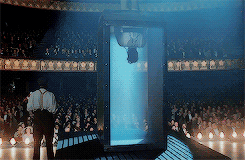
Obviously, the first person that comes to mind is Harry Houdini, a man whose feats have lasted the test of time, and may have led to his death. Not only did he get buried alive, not only did he escape from a straitjacket in chains underwater, NOT ONLY did he hold his breath inside a water-filled milk can inside of a wooden chest repeatedly for FOUR YEARS, but he was also the greatest enemy of spiritualists and mediums everywhere!
Yeah, despite being a stage magician, Houdini was OBSESSED with exposing those who claimed to be actually supernatural. After all, as a showman, he was interesting in exposing tricks that were meant to defraud the innocent public. Dude was awesome, is what I’m saying. He died from a burst appendix, which miiiiight have been caused by a student who punched him in the stomach after asking if he was actually resistant to abdominal damage. Yeah, not a great death. And he wasn’t the only illusionist to die of tragic circumstances, but that’s a discussion for another day. Because of this is sci-fi month...why am I talking about magic? Well...imagine a lighter.

Now image that you went back 5,000 years, to any civilization, and showed them a lighter. The ability to create fire with seemingly nothing but your bare hands? You’re basically a wizard! Fire from no visible fuel? TEACH ME YOUR WAYS, O SORCERER OF THE FLAME!!! And that’s just a goddamn lighter.
What about a light bulb? Light from energy you’ve harnessed from metals and from the air itself? Jujube! A camera? With the ability to capture a moment in time in the form of a tangible image? WITCHCRAFT!!! A smartphone? A FUCKING SMARTPHONE???

And so, in celebration of the blurring of magic and science...why not start this month with an unconventional form of science fiction, huh? Something that blurs magic and science in a way that’s indistinguishable. And so, I can FINALLY watch a movie that I’ve wanted to watch for YEARS!

I am so excited, and this is a hell of a way to kick off the month! Why this? Well, I’ll explain that later. But for now...LET’S DO THIS.
SPOILER ALERT!!!
Recap (1/2)
There are three acts of magic.

First is “the pledge”, where the magician shows something normal. Then, there’s “the turn”, which is when the ordinary becomes extraordinary. And finally, there’s the act of bringing the show full-circle; bringing back a disappeared object, in a new way and with a new technique. That final act, the showmanship, the establishment of the mystery, is called “the prestige”.
So is told to us by John Cutter (Michael Caine), keeper of canaries and stage engineer to magicians, via narration abut magic. Intercut with that narration, and with a disappearing canary trick, is the presentation of an act being performed by Robert Angier (Hugh Jackman). In it, he turns on a machine using electricity, with lightning bolts flying freely. He steps inside of it, and disappears.
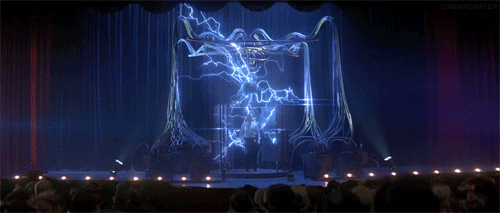
Meanwhile, coming from the audience, a man pretends to be part of the act, and goes backstage and underneath the machine. There, he witnesses Angier fall through a trap door into a water tank, unable to get out, panicking and drowning. Which is just super fun to watch, lemme tell you! And that is where the story starts.

The man from the audience was Alfred Borden (Christian Bale), who is quickly put on trial for the murder of Angier. A rival of his during the 1890s and early 1900s, Borden is sent to jail, and sent to death by hanging. This is as his young daughter watches on. In court, Alfred testifies against Bruce Wayne on how he murdered Wolverine, because this is all I could think of the entire time. Anyway, the court asks for more details on the trick that killed Angier, called “the Transported Man”. He refuses to divulge it publicly, but agrees to tell it to one of the judges in secret.
In prison, Borden’s visited by a representative of a wealthy collector of items, Lord Caldlow. He asks if he will sell him his most prominent trick, the “Transported Man”. But Borden also refuses, as it’s HIS trick. Still, in response, the man gives Borden a journal of Angier’s’, and asks him to think about selling the secret. And from there: flashback!

Angier is on a train, heading to Colorado Springs, where he’s surprised to see that the whole town has electricity. His plan is to go up the mountain, which is closed for scientific experimentation. Which isn’t ominous at all! That completely banal revelation is followed by a walk up the mountain in the fog, past a fence that says no trespassing and LITERAL WARNING SIGNS.
There, he’s greeted by Alley (Andy Serkis), the assistant of the estate’s owner. Apparently, said owner made a machine for Borden, and Angier wants to learn the secrets. Another flashback, and we learn that Borden and Angier, rival magicians now, met a long time ago at the show of another magician, both volunteering to tie up the female assistant, Julia (Piper Perabo). Which would be creepy out of context, and then is creepy IN context when Angier kisses her thigh. Ew.

Anyway, they drop her into a tank, with a pretty stereotypical trick. After the show, we also learn that these two men are actually working for the magician, Milton (Ricky Jay), which makes that thigh kiss less creepy. Talking to Cutter and Julia, Borden mocks Milton’s trick, noting that the old magician won’t even try something like a bullet catch. Cutter mocks this idea, and asks if Borden has any better ideas. It’s around this time that Cutter suggests seeing Chung Ling Soo. Huh. I won’t say anything about that until later.

Or right now! And, uh...oh shit, this is extraordinarily awkward. Here’s the thing: this is NOT Chung Ling Soo. I know this for two reasons. One, Soo didn’t really pretend to be crippled, as Borden and Angier suggest. Wasn’t really his bag. But something that IS interesting about the guy is how he died! BULLET CATCH TRICK!! Yup! He tried the bullet catch trick, and he died when the bullet actually fired at him! Yeah, awkward.
And you know what else is awkward, and really different from this story? Chung Ling Soo was...not Chinese. Even a little bit. His real name was William Ellsworth Robinson, he married his assistant, cheated on her with another assistant, never divorced and still married his new assistant illegally, etc. He was an interesting guy. Ignoring, y’know, the whole disgustingly shitty yellow-face thing. Different times, unfortunately.

Borden’s frustration with an act he considers boring and obsolete erupts during one of Milton’s shows, where we see him KILL A BIRD, FUCK ME MAN. Yeah, I get it, Borden, this is terrible! This coincides with meeting a young woman and her nephew, who is also upset to see a bird die in front of him. The woman is Sarah (Rebecca Hall), and the two start a romance. Meanwhile, the romance between Angier and Julia is a straight-up marriage, making that thigh kiss fare more understandable. And, the two are about to have a baby, to both of their delight! Nothing bad will happen now!
We flash forward to the future, where Cutter is showing the judge what’s what with the device. He claims that a wizard built it, and that the machine can actually do what magicians have only pretended to do for years. They also look at a tank, and Cutter reveals that the tank has a terrible history, especially for the two magicians.

Flashback again, to a night of yet another show. That night, Milton and the group go through with their trick, as per usual. However, Borden decides to make it a little tougher and more exciting by tying a different knot this time. And unfortunately...Julia can’t untie it. They try to get her out in time, but alas...it’s too late.

Julia dies, and Angier blames Borden, who isn’t even entirely sure if he tied the knot that killed Julia...allegedly. Not a big fan of Borden right now. The act is over, and Borden decides to split off and do his own act, calling himself “the Professor”. Now having a child of his own with Sarah, he decides to do a bullet trick, with the help of new stage engineer, Fallon. But this is a tricky trick to perform. And the understandable mental breakdown of Angier causes its own problems.
See, during one of Borden’s shows (which is going TERRIBLY), a disguised Angiers shows up and loads a REAL bullet into the gun for the trick, and BLOWS OFF TWO OF HIS FINGERS FUCK ME!!! Borden’s not exactly happy about this, but he recovers quickly. Shortly after, Cutter finds Angier at a bar, and offers him the opportunity to make a new show of his own. Reluctantly, he accepts, and takes up the moniker “the Great Danton”, a name that his late wife suggested.
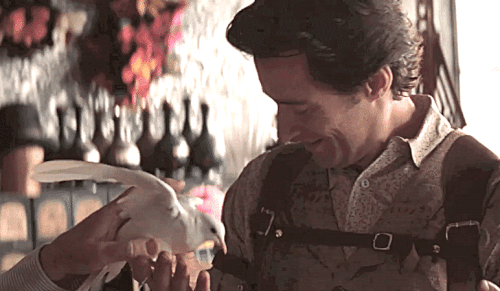
With a new bird/cage trick, one that lets the bird LIVE (THANK YOU), they’re almost set. But they also add a new assistant, in the form of...Black Widow. I mean, sorry, Olivia Wenscombe (Scarlett Johansson). Yeah, um...Wolver, Alfred Pennyworth, and Black Widow are working together in competition against Batman. Also, Gollum is in the movie, too. God, what’s next, David Bowie?
Anyway, the show is on once again, and Angier asks for some volunteers in the audience. But, uh oh! One of them is Borden in disguise, and he sabotages the trick in front of EVERYBODY, breaking an audience member’s fingers, and killing the bird, completely fucking up Angier’s career, in revenge for his fingers. Oh, also, MOTHERFUCKER YOU KILLED HIS WIFE (maybe)!!! Doesn’t justify Angier shooting off your fingers, but you could’ve just let bygones be! No wonder you’re rivals in the future! Batman’s a dick (which, given Christian Bale, isn’t that surprising).

Well, since his trick, Angier’s fucked. They’re kicked out of the theater, and in need of a new act. Cutter suggests that Angier goes to the upcoming science exposition for ideas. And yes...that’s where the science fiction angle starts in. See, like Clarke said, any science that’s sophisticated enough LOOKS like magic to audiences who don’t understand it. And Borden has the same idea, as he also heads to the expo.
It’s there that a presentation of a massive electrical generator is being held, with the machine having been invented by...Nicola Tesla! YO!

I don’t think I need to tell anybody about Tesla at this point, but he was a brilliant physicist and inventor from the early 1900s. His legendary Current War with Thomas Alva Edison for the current to be used by the United States (Tesla’s DC vs. Edison’s AC) is the stuff of science legend...and is a conflict that the far less charismatic Tesla lost. Still, his mastery of electricity (such as the above Tesla coil) is remembered today. If you want to go sightseeing, check out New York! In Niagara Falls, he’s got a massive statue overlooking the falls; and in Bryant Park in NYC, you can sit on the bench where he fed his beloved pigeons. Yeah, he loved pigeons, which I respect.
Anyway, the expo’s shut down due to presumed danger of the exhibit, possibly spurred on by Thomas Edison and his PR team. Which is pretty accurate, not gonna lie. Still, the experiment interests both Angier and Borden. Still, Angier doesn’t do much with this information. Right now, anyway.

Flash forward to Angier in Colorado Springs, and a group of men from Edison’s employ are there for some reason. But undeterred, Angier heads back to Tesla’s lab, where Alley shows him a gorgeous sight: lightbulbs dotting a field, making a gorgeous grid of light. He reveals that the source of the electricity is 15 miles away, as a testament to Tesla’s scientific genius. Stellar.

A great place to pause. See you in Part Two of this Recap!
#the prestige#christopher nolan#christopher priest#hugh jackman#robert angier#angier#christian bale#alfred borden#michael caine#scarlett johannson#rebecca hall#andy serkis#piper perabo#david bowie#science fiction may#sci-fi may#user365#365 movie challenge#365 movies 365 days#365 Days 365 Movies#365 movies a year#userbrit#usercoppola#usermaria*#ridleydaisy#bbelcher#userkristen
21 notes
·
View notes
Text
Epilogue: Underwater (SC Titanic, Zetta x Adele Series)
As promised, here the epilogue of the Zetta x Adele Series, folks.
This is the very end of a project that meant me quite a lot to me and got me through the last terrible year. Thanks to all those who supported it: hope you enjoyed it and will enjoy this ending.
In case you were wondering, this song inspired the whole series, particularly the last chapters:
youtube
I will skip the tag list for once since it’s pointless anyway.
➡️ Ch. 1, Ch. 2/1, Ch. 2/2, Ch. 3, Ch. 4, Ch. 5, Ch. 6, Ch. 7, Ch. 8/1, Ch. 8/2, Ch. 9, Ch. 10/1, Ch. 10/2, Ch. 11/1, Ch. 11/2, Ch. 12, Ch. 13, Ch. 14, Ch. 15 , Ch. 16, Ch. 17
_________________________
Almost a century after the sinking of the RMS Titanic and to celebrate Canada becoming the first country outside Europe to legalise same-sex marriage, the Canadian Film Institute decided to work side by side with several LGBTQ+ organisations across the world to put together an exhibition focused on the early queer cinema and the many queer stars who were forced to hide their true selves in the Golden Age of cinematography, spanning from 1890s till the aftermath of Second World War. "A testament to the role the LGBTQ+ community played in the history of cinema and that we have always been here, even if people hardly saw us" as a journalist wrote on a queer magazine.
After the recent discovery of some private documents, the curators were overjoyed to include an icon of the 1900s - 1910s cinema like Zetta Serda into the retrospective and cast a new light on her extraordinary career sadly soon forgotten after the advent of the sound era. Yet, the silent picture star was mentioned as a model and 'endless source of inspiration" by many queer movie stars like Cary Grant, Katherine Hepburn, Greta Garbo all part of the retrospective. Rumor has it that as soon as she landed in America, Marlene Dietrich demanded his agent a meeting with Mrs King.
A curator drove all the way to Montreal to meet the last known heir, a certain Mrs. Julia Nowak, who greeted him on the threshold of a cosy downtown apartment. She offered him a coffee and a slice of a Polish sweet bread: the recipe was a family heirloom, she explained, beaming. She was in her late fifties, a therapist, she said. Her hazel eyes gleamed when she added, in a pleasantly soothing voice that betrayed a hint of excitement:
"I must confess I am so incredibly happy that you contacted me about the retrospective. I adore the idea and I will make sure to attend it. Also" she nodded to a wedding picture hung to the wall "did you know that my wife is in politics? She campaigned for the legalisation...yes, Madeleine Fournier: see, you know her! We got married right after the law passed. If anything, your call and project made me twice as happy".
She took a pause, smiling over her coffee in remembrance.
"Anyway, back to the matter of your visit...yes, as far as I know, I am Zetta's last heir. As you probably know, my family wasn't officially related to her but she stated otherwise in her will".
She moved to the couch and gestured the curator to follow her as she opened up one of the boxes and chests piled into the living room and picked out an old album, the leather cover worn at the edges. Dust waltzed in the air as she opened it with caution and gentle care. She showed him a slightly discoloured black and white picture of a young couple kissing for the camera in front of a church. Another wedding picture, from a different era.
"Nana Hileni and Papa Maciej's wedding picture. I still remember them even if they both died when I was barely a teen...as if one couldn't bear to live without the other. Or so I like to think. She would help me with the homework, mathematics particularly, and he baked this bread for me till he was too weak to do so. He always claimed that he won Nana's heart with his pastries but she always denied it laughing".
She passed another picture of the same couple proudly standing in front of the Nowak family bakery in Hoboken.
"Frankly, I believe that Papa's broad shoulders and Marlon Brando smile are more likely to blame for this coup de foudre" she laughed. "And he knew how to deal with her no-nonsense attitude and vice versa. They...balanced each other, if you wish".
She picked another picture and handed it to him. A woman was looking down in tender adoration and awe to a baby nestled in her arms looking up at her, outstretching a tiny arm in an attempt to touch her face.
"There! This is Dad" she pointed at the baby before turning the picture where someone wrote 'Alex meets Auntie Adele'. Turning it again, she pointed at the woman.
"This is Adele Carrem. Or Auntie Adele as I've always heard calling her. Nana's sister and Zetta's publicist and companion"
Putting it back into the album, she carefully picked a bunch of other old pictures.
"You surely know who this one is" she smiled, handing out the one on top.
The photo was rather grainy but you could still recognise the same kid, slightly older, around two, sucking his thumb, cuddled up in Zetta's lap. The actress had aged a little but her features were unmistakable and it was endearing to see her sitting by the fireplace to read that kid with the sleepy face a bedtime story.
"Sadly, I have never met them. I wish I did, oh you have no idea...but stories of them lived through in our family" Julia continued. "My Dad loved his Aunties - as he called them - dearly and by what I've heard and read, they loved him in manner as if he was their own. He knew little of them or Zetta's career back then...to him they were just the sweet ladies who would buy him ice-cream in Central Park or take him to see his favourite pictures over and over again at the movie theater. He said he will never forget the afternoons he used to spend with them in a Manhattan cafe that no longer exists around Christmas: Nana and Papa worked like crazy as the festive season approached and the glorious cup of hot chocolate with an elegant puff of cream on top with the Aunties became a tradition to him. He kept it alive somehow as he did the same with me".
She handed the curator a bunch of other pictures: Zetta cleaning up Alex's face smeared with jam, the both of them laughing; Zetta posing with Maciej and her Dad at a table in the Hoboken bakery. He eventually mirrored her smile seeing a five years old Alex at the beach all engrossed in building a sandcastle with Hileni and Adele, and he standing at the water edge hand in hand with Miss Carrem, looking out into the distance.
"These are family pictures. I'll show you the Zetta's private memorabilia we cherished".
Julia searched a little, opening an old chest and handling every item inside with tender care. When she found what she was looking for, she showed the curator an elegant set of smaller boxes containing letters, dried flowers and photos.
"I have already received an offer to get these published. I'm still pondering it. Before agreeing, I want to consider throughly if this is a thing they would have wanted, even if they're no longer here"
The curator nodded as she kept searching. He skimmed a few letters and smiled as his eyes fall on the photos hidden away in those boxes: the two women sitting together and chatting at Hileni's wedding, Zetta's reading a script, lazily sprawled on a chaise long in her apartment. Some had short lines handwritten on the back, like a promotional picture with "Missing you" written by Zetta herself. The curator showed another to Mrs Nowak: a visibly excited Miss Carrem proudly showing to the camera a document announcing her voter registration. On the back, in Zetta's penmanship: "On the way to vote...my sweet Adele won!".
"Oh you didn't know? Auntie Adele was a suffragette! I couldn't believe it when I first heard it! Nana told me that she was in and out jail when they lived in London because of protests. You know, like those suffragettes you read about in history books but less famous. Yet she fought for women's rights and kept fighting for them even in America. She was quite disappointed though by some major decisions of some feminist movements and eventually joined a socialist Union 'more rightfully welcoming working class individuals, immigrants and black brothers and sisters'. It's all in those letters but yeah, you couldn't possibly know. So little is known about her outside family".
A little smile drew on her face as she put back the photo.
"That photo was taken the day of the first election open to women. I checked the date. I suppose Zetta wanted to immortalise the moment...it was sweet of her, huh? Auntie Adele must have been so proud and overjoyed that day! You know, my Dad was born in 1920 when women's right to vote was legalised nationally and Nana once told me that Auntie commented the lucky coincidence saying she was incredibly happy her nephew would get to live in a fairer world. She was a true force of nature...she never talked much of the sinking of the Titanic just like Zetta and Nana actually but when one day Dad asked...he was barely a child and probably found an old article about the tragedy...Auntie Adele minimised but Nana assured him that her sister saved her life that night, risking her own to go down to the belly of the sinking ship to bring her to safety. Auntie simply shrugged, saying that it was what sisters do and that they made it to the lifeboats only thanks to Zetta, who shouted protests to stubborn officers and eventually found them a spot on a boat. I cannot even bring myself to imagine how scary that must have been: I cried so much when Madeleine took me to see Leo and Kate...to think they were there and it was all real!"
She picked a few other objects out the box: a Shakespeare Sonnets book in a leather cover with golden engravings, with a little handwritten dedication 'To Adele, my sonnet 116. Happy birthday! With all my love, Zetta'; old scripts with annotations, a framed photograph of Adele and Zetta slow dancing barefoot in the living room of a gorgeous Long Island mansion.
"These have a sentimental value" Mrs Nowak noted, her voice betraying the flicker of emotions as she picked it up.
She took a deep sigh and continued.
"I remember the day I told Dad I was gay as it was yesterday. We had always been quite close so it came natural to tell him first. We were in his car, he had come straight from college to pick me up at ice-skating practice. I..I dropped it in the middle of a conversation, bracing myself for the worst. I heard so many bad stories about coming out to your parents I was terrified of the consequences but I couldn't hide it anymore. I mean, yes, in public: bullies get even nastier if they know and I didn't want people shouting me "dyke" at school. But I needed to get it out of my chest...with someone at least. He kept quiet for a moment and I felt like drowning in shame. But then he spoke".
A nostalgic tender smile formed Julia's lips.
"He said he had two amazing Aunties that contributed to make his life a wondrous adventure. It was thanks to them that he, the son of a baker, could attend a prestigious college, for instance: they offered to pay for it without asking a penny back. They also helped him write his first romantic letter to his childhood sweetheart and consoled him when the little girl turned him down. But his Aunties had a secret, he added. He said: to my kid eyes they were no less a couple than Mom and Dad and at home we all treated them in manner but one day Mom made me promise to behave differently when we were in public. In public I would refer to her sister as 'Auntie Adele' but call Zetta by her name. He didn't get it and it took some getting used to. He soon noticed that even the Aunties behaved a bit differently out in the sun: they wouldn't hold hands or use endearing words in the street or when other people were around. They simply behaved like good friends did. He understood it later when he, as stubborn as a mule, asked them directly".
Julia gently grazed her fingers on the glass of the framed photograph, caressing it.
"And they told me everything, he said. That they were in love, just like mom and dad were, but people out there could be uncomfortable and extremely rude to women loving other women and men loving other men. That they kept their companionship a secret in public because those people had no problems with women being friends and they didn't want to have bad words or worse happening to them. I remember asking him what he thought about it. He smiled. 'I cried. Since Auntie Zetta mentioned people claiming that women like them were sick and would burn in hell, I actually started crying. I sobbed desperately in her arms, crying that I didn't want them to burn in hell, I loved my Aunties and I was happy they loved each other. Eventually they explained me it was just a vile lie spread my malignant people. But I got quite a scare and kept staring at them with puffy red eyes and my face wet with tears for a while. It required lots of cuddling to bring a smile back on my face'. He shook his head, laughing of his endearing naivety. Then he pulled over and looked at me. He continued: 'I still don't get why people keep spreading those mean lies but I know for sure that my Aunties weren't sick and didn't end up in hell and so won't you. Don't believe bullshits like that for a split second, okay? And I also want you to remember that it doesn't change a thing for me and mom too. You will always be my little girl, our little girl and we love you'. We shared a long hug before driving back home. On the way back he insisted to buy my favourite chicken and waffles for dinner, saying mom's veggie soup could wait. For my birthday, a month later or so, he asked me to follow him to the attic and showed me this chest. To meet the Aunties that 'would have surely been there for me'".
She tipped away a tear.
"I told you I married Madeleine right after the legalisation of same-sex marriages. My wedding was also the last public event Mom and Dad attended together before his health worsened irremediably. He passed away last year".
For a moment she looked on the verge of tears but she recovered quickly.
"Sorry...anyway, that day Dad insisted on walking me down the aisle even if he was getting weak. He beamed with pride when a friend fixed a rainbow ribbon to his jacket. Later at the lunch he read a speech he had written for the day, his hand shaking. He shared the story of his Aunties. He said that despite the hardships their situation forced upon them, they had quite a happy life together, a happiness carefully hidden from the world. He wished us to find something similar to what they shared without needing to hide anymore. He said Adele and Zetta would have been so happy and proud to celebrate with all of us that day"
Mrs. Nowak picked the Shakespeare Sonnet book and gave him a fond look.
"He brought this to the wedding. And he read for us the sonnet 116, the one Zetta mentioned in her dedication. You know, the one that starts with 'Let me not to the marriage of true minds admit impediments..."
-----------------------
A few months later the exhibition on old Hollywood queer cinema and artists opened. Each artist had a room that soon filled with a crowd of enthusiastic visitors.
In the first half, in a room arranged as a turn of the century nickelodeon with velvet chairs, all the memorabilia of Zetta Serda's public life: panels explaining the various stages of her career and the birth of her myth, promotional pictures of her performances, articles about her and a copy of a gazette announcing her wedding with the director Richard King. On the wall, on a screen her entire filmography rolled up in loop, bewitching spectators after a century. In display cases: the gorgeous sapphire necklace she wore on her last night on the Ship of Dreams and at the movie party of Surviving the Titanic, and a replica of her Cleopatra costume. The aging Queen of Egypt with a tragic love and destiny immortalised by Shakespeare was her last role back on the theater stage before retiring from the scenes. Old scripts with her personal annotation were displayed with photographs taken on sets and mundane events.
The wall hosting the motion-picture screen cut the room in half. On the other side, the hidden half of her life. Her life with Adele no one suspected back then. A life kept secret that now unveiled in front of the eyes of the visitors.
The curators discovered that finding public pictures of Miss Carrem was nearly impossible, true to the nickname she acquired as time went by: The Shadow. She stayed at Zetta's side until and even after she stopped acting, showing rare loyalty and devotion, but ever surrounded by this mystery allure. No one, even the most stubborn reporters managed to know anything about her and she was soon dismissed as a Titanic survivor, possibly a fan, who worked as Zetta's secretary and somehow gained her respect. Little they knew about the depth of their relationship and what stacks of secret letters and family memories revealed of the life of Miss Carrem. A panel finally told her story and her secret achievements: Adele, or better Adal, kept fighting for a fairer world and society her whole life and marched for women's right to vote on the famous parade in 1915. She also passed the teaching of Edith Garrud to her American sisters.
The only pictures of her came from the Nowak family, except for one. The only photograph of a public appearance of Miss Carrem as well as the only known public appearance of Zetta and Adele. An old grainy photo accurately framed showed Adele shaking hands with The Unsinkable Molly Brown on a podium. In her free hand a shiny medal and a few steps behind the mayor of New York.
According to the panel, the survivors' committee founded by Mrs. Brown decided to award Miss Carrem a medal for bravery and a generous check "to help her and her sister starting a new life in America". With great surprise, Miss Carrem received the medal and the check, thanked the board but refused the honors. Instead, she asked to deliver them both to the family of a certain Charlie Stoke, a stewart that lost his life in the sinking to save her life and those of many passengers. She added that her friend expressed the desire to study naval engineering one day and she wished that the money kindly offered to her would be enough to establish a scholarship for boys like him across the ocean. In another picture, Miss Carrem and her sister chatted with Moll Brown in company of Zetta. Eventually, other philanthropists and wealthy socialites signed checks for her cause so that the Stoke family received a generous contribution too. And today, as another picture confirmed, the faculty of naval engineering of the University of Newcastle hosts a marble engraving of Charlie Stoke: to his memory a scholarship had been instituted one year after on the anniversary of the sinking. Since 1913 it has been helping students of poor background to get an education and improve their life.
Zetta herself became a philanthropist during her Renaissance and ever since. The first act of her new phase of her life was joining the Moll Brown survivors committee to provide help to the second and third class passengers families and survivors. Some said that the tragedy she witnessed touched her heart, other claimed that it was to be attributed to the influence of her publicist. Jokingly, she used to say that after all, she had too much money yet all she could have wished for in her life, so why not doing some good with it? A considerable donation under her and Mr King was received by the main hospital during the Spanish flu pandemic; she was particularly active in providing financial help to struggling neighbourhoods and female education institutions.
In the middle of the room, a long glass display hosted the Shakespeare Sonnets opened at sonnet 116 and a selection of the private correspondence between Zetta and Adele.
My darling,
You will receive this letter tomorrow morning when I'll be already off to Chicago. The suitcases are ready and packed, this is a goodnight note scribbled the night before leaving you to remind you how much I love you and care about you. How much I'm going to miss you even if - thank God! - we won't be parted for long...
Do not forget you promised me to write every day! Write to me, Adele, write to me whatever thought crosses that gorgeous mind of you: you know I could you rambling for hours without getting tired of the sound of your voice, of your sparkling wisdom. I wanna know everything. So don't be shy: I'll be waiting your letters with tender impatience.
Can't wait to be in your arms once more.
Adoringly yours,
Zetta
-
Dear, dearest Zetta,
I went to Central Park today with Hileni. It was a gorgeous spring day, sunny, a gentle breeze blowing: 'simply too beautiful to be wasted inside' as my sister put it. Did I tell you that she's still exchanging letters with the delivery boy from the hat shop? I thought they were over but apparently he invited her to the nickelodeon next week.
Anyway, walking in the park with her I suddenly realised how I wanted to share that spring wonder with you.
When are you coming back to New York? Tell me soon, please. And even 'soon' won't be soon enough: you're always on my mind since you left. But yes, tell me soon so I can make you promise we will go for a walk before the weather becomes too hot.
Do you think I can wrap my arm with yours? Is it professional enough for a publicist? Even just for a few steps: oh you have no idea how I would love that! Or maybe you have? I hope so: it'd mean you miss me as much as I miss you when we are apart.
Oh, I almost forgot: all settled with that magazine you mentioned before your departure! I negotiated a two pages long interview, plus pictures. And a cover mention.
Hope I did well: you have already fired me as your secretary, I must prove you I am just what you're looking for in a publicist...
Can't wait to see you again!
Loving you always,
Adele
Only one letter was copied on a panel of its own on the main wall side by side with a blow-up of the picture of Adele and Zetta slow-dancing barefoot and free, for a blessed moment immortalised in a discreet shot. Adele pressing a tender kiss on Zetta's forehead, drawing a soft smile on the acrtress' lips. Many visitors commented it was heartwarming to see such a photograph that conveyed the intimacy and the warmth of affection radiating from the dancing couple. Some said that Zetta was even more beautiful like that: free, hair slightly askew and genuinely happy, loved.
What stole their hearts away though was the letter attached to it. It was no surprise that the curators decided to name the retrospective Underwater.
Dearest Adele,
Forgive me for the tone of this letter. I am writing it down in bed while I cannot sleep and my mind runs back to you as if we could meet halfway between the miles separating us, in a world of fantasy of our own.
It's ridiculous how much I miss you! I want you near, I need you near all the time. Take tonight: if you were here with me, I would be heavenly sleeping in your loving embrace. Most unfortunately, you are not and I'm lying here, insomniac, thinking of you. And about my life.
No, don't frown. I am not getting all sad again. It's...bittersweet. And - I'll spoil you the ending so you will stop worrying, hopefully - it gets better the more you proceed.
Have you ever felt trapped underwater? I did, my whole life. Always hiding, always measuring words, gestures, gazes not to let them see, not to let them know...so little time to go up and break the surface. Drop the mask and breathe. In, out. Once, twice. In my lowest moments I repeated to my myself: how are you gonna survive?
One day an acquaintance with a remarkable passion for the sea explained me and the other bored commensals that you can keep someone alive by breathing oxygen into their mouth underwater. Pretty much like mouth-to-mouth resuscitation helps an unconscious person to regain consciousness. I found it interesting but doubted his words.
Then I met you, Adele. My dearest, wondrous Adele. And I learnt that yes, you can't breathe if you're constantly underwater...but you won't drown if you have the right person swimming by your side in those deep waters.
Put your lips on me, Adele. Touch me, hold me in your arms. And I can live underwater.
With your love, I can live underwater.
We can live underwater.
I love you.
I want to cover a full page of these three simple words: I love you.
I want to cry them out and entrust them to the winds, to the night.
But what for? Who cares if the world knows or not?
I'll whisper them over your lips when we will be reunited.
So you can breathe underwater.
Counting down the hours separating us, my love.
Eternally yours,
Zetta
35 notes
·
View notes
Link
LETTERS FROM AN AMERICAN
July 11, 2021
Heather Cox Richardson
On Friday, as President Joe Biden signed “An Executive Order Promoting Competition in the American Economy,” he echoed the language of his predecessors. “[C]ompetition keeps the economy moving and keeps it growing,” he said. “Fair competition is why capitalism has been the world’s greatest force for prosperity and growth…. But what we’ve seen over the past few decades is less competition and more concentration that holds our economy back.”
Biden listed how prescription drugs, hearing aids, internet service, and agricultural supplies are all overpriced in the U.S. because of a lack of competition (RFD TV, the nation’s rural channel, has a long-running ad complaining of the cost of hearing aids). He also noted that noncompete clauses make it hard for workers to change jobs, another issue straight out of the late nineteenth century, when southern states tried to keep prices low by prohibiting employers from hiring Black workers away from their current jobs.
“I’m a proud capitalist,” Biden said. “I know America can’t succeed unless American business succeeds…. But let me be very clear: Capitalism without competition isn’t capitalism; it’s exploitation. Without healthy competition, big players can change and charge whatever they want and treat you however they want…. “[W]e know we’ve got a problem—a major problem. But we also have an incredible opportunity. We can bring back more competition to more of the country, helping entrepreneurs and small businesses get in the game, helping workers get a better deal, helping families save money every month. The good news is: We’ve done it before.”
Biden reached into our history to reclaim our long tradition of opposing economic consolidation. Calling out both Roosevelt presidents—Republican Theodore Roosevelt, who oversaw part of the Progressive Era, and Democrat Franklin Delano Roosevelt, who oversaw the New Deal—Biden celebrated their attempt to rein in the power of big business, first by focusing on the abuses of those businesses, and then by championing competition.
Civil War era Republicans had organized around the idea that the American economy enjoyed what they called a “harmony of interest.” By that, they meant that everyone had the same economic interests. People at the bottom of the economy, people who drew value out of the products of nature—trees, or fish, or grain—produced value through their hard work. They created more value than they could consume, and this value, in the form of capital, employed people on the next level of the economy: shoemakers, dry goods merchants, cabinetmakers, and so on. They, in turn, produced more than they could consume, and their excess supported a few industrialists and financiers at the top of the pyramid who, in their turn, employed those just starting out. In this vision, the economy was a web in which every person shared a harmony of interest.
But by the 1880s, this idea that all Americans shared the same economic interest had changed into the idea that protecting American businesses would be good for everyone. American businessmen had begun to consolidate their enterprises into trusts, bringing a number of corporations under the same umbrella. The trusts stifled competition and colluded to raise the prices paid by consumers. Their power and funding gave them increasing power over lawmakers. As wealth migrated upward and working Americans felt like they had less and less control over their lives, they began to wonder what had happened to the equality for which they had fought the Civil War.
Labor leaders, newspapers, and Democratic lawmakers began to complain about the power of the wealthy in society and to claim the economic game was rigged, but their general critiques of the economy simply left them open to charges of being “socialists” who wanted to overturn society. Congress in 1890 finally gave in and passed an antitrust act, but it was so toothless that only one senator in the staunchly pro-business Senate voted against it, and no one in the House of Representatives voted no.
Then, around 1900, the so-called muckrakers hit their stride. Muckrakers were journalists who took on the political corruption and the concentration of wealth that plagued their era, but rather than making general moral statements, they did deep research into the workings of specific industries and political machines—Standard Oil, for example, and Minneapolis city government—and revealed the details behind the general outrage.
Their stories built pressure to regulate the robber barons, as they were called by then, but Congress, dominated by business interests, had no interest. Instead, President Theodore Roosevelt and his successor, William Howard Taft, tended to rein in the trusts through the executive branch of the government, especially by legal action undertaken by the Department of Justice.
On Friday, Biden promised to use the power of the executive branch to rein in corporations, much as Theodore Roosevelt did during his terms of office. But there was more to Biden’s statement than that. His emphasis on restoring competition is from the next historical phase of antitrust action.
In the 1912 election, political language turned away from the evils of trusts and toward the economic competition so central to American life. Both Republican Theodore Roosevelt and Democrat Woodrow Wilson centered their campaigns around the idea that big business was strangling competition. Wilson called for a “New Freedom” that would get rid of the trusts once and for all and return the nation to a world of small enterprise and opportunity. Roosevelt scoffed at this idea. He talked of the “New Nationalism,” in which a large government would restore competition by regulating big businesses. (He said that if you got rid of trusts and then looked away, they would immediately spring up again.)
While their solutions were different, both Roosevelt and Wilson had reframed the stratified economy not solely as a problem, but also as an opportunity. Trimming the sails of the corporations was not an attack on the liberty of industrialists, but rather a restoration of the competition that had, in the past, enabled the country’s economy to thrive. And, once elected, Wilson managed to get key items of that agenda passed through Congress.
That positive emphasis on competition carried into the administration of the next Roosevelt president, FDR. Biden noted that FDR called for Congress to pass an economic bill of rights, including “the right of every businessman, large and small, to trade in an atmosphere of freedom from unfair competition and domination by monopolies.” And indeed, the idea of restoring a level playing field for all businesses, rather than letting them succeed or fail based on the whims of economic wirepullers, persuaded businessmen who had previously opposed regulation to line up behind the establishment of our Securities and Exchange Act of 1934.
Americans have lost this tradition since 1980, Biden said, when we abandoned the “fundamental American idea that true capitalism depends on fair and open competition.” Reframing business regulation as “laws to promote competition,” he promised 72 specific actions to enforce antitrust laws, stop “abusive actions by monopolies,” and end “bad mergers that lead to mass layoffs, higher prices, fewer options for workers and consumers alike.”
For 40 years, the Republican Party has offered a vision of America as a land of hyperindividualism, in which any government intervention in the economy is seen as an attack on individual liberty because it hampers the accumulation of wealth. Biden’s speech on Friday reclaims a different theme in our history, that of government protecting individualism by keeping the economic playing field level.
—-
Notes:
https://www.whitehouse.gov/briefing-room/speeches-remarks/2021/07/09/remarks-by-president-biden-at-signing-of-an-executive-order-promoting-competition-in-the-american-economy/
LETTERS FROM AN AMERICAN
HEATHER COX RICHARDSON
#political#Heather Cox Richardson#Letters From An American#capitalism#history#fair competition#competition#hyperindividualism
6 notes
·
View notes
Text
History of Chinese standing collars (part 1: Ming & Qing)
So, a lot of people nowadays refer to a certain type of standing collar as a “Mandarin collar” but I'm not sure if that’s legit, because standing collars throughout Chinese history looked different. I was confronted by this topic when I was writing my post on 1950s Chinese fashion and felt like I had to make a separate post. I’m gonna do a quick break down of all the different types of standing collars in historical Chinese fashion from the 16th century to the present and how they developed.
Ming Dynasty (1368-1644)
The first mature 立领 liling standing collars were applied to women’s robes in the late 15th/early 16th century. Before any garment with a standing collar was invented, both men and women in Ming China wore garments with either a 圆领 yuanling round collar, 直领 zhiling parallel collar or 交领 jiaoling crossover collar, with crossover collars being the more common in womenswear.

Source here
Early Ming Dynasty portrait of a lady in a crossover collar robe.
The development of a standing collar was in large part thanks to the invention/adoption of the 子母扣 zimukou metal clasp button. I wonder why the fabric knotted buttons used on round collar robes were not used on standing collars in this period? They were awfully similar to the pankous of later. Anyway, at one point in the 15th century, some women thought it would be cool to add zimukou to their clothes and it resulted in this (they were also used on 比甲 bijia, 半臂 banbi and 短衫 duanshan but those are irrelevant to collars):
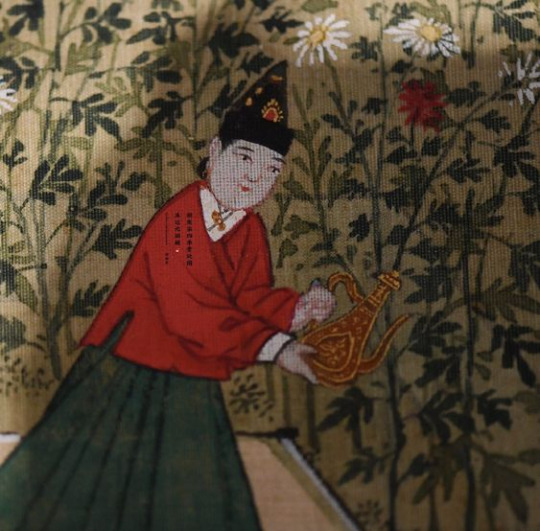
Source here
Part of 明宪宗元宵行乐图 (a painting depicting various Lantern Festival activities at the court of Emperor Xianzong), 1485. This lady is wearing a crossover collar robe with a zimukou at the middle.
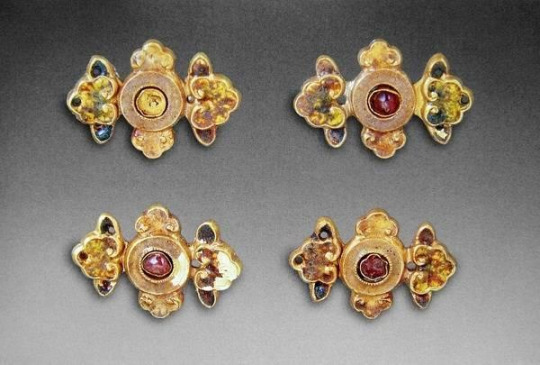
Source here
Modern reproduction zimukou. You could buy these for cheap on Taobao if you want to sew your own Ming style hanfu btw.
In the 16th century a fashion revolution took place in China: the standing collar, which came out of nowhere, began to suddenly dominate women’s clothing. This OG Chinese standing collar was very tall and form fitting, usually covering all of the wearer’s neck. It had sharp, rectangular edges and was closed by two zimukou, one placed at the bottom of the collar where it meets the bodice and another slightly above, not reaching the top of the collar. An important feature that set this apart from the collars of the 20th century is that it was unstiffened and made of the same fabric as the robe, meaning it was soft and could be worn with the top bit folded over, showing the lining which could be of a contrasting color. For archival purposes let’s call this collar style 1.
There are various theories as to why the standing collar was invented, e.g. because of colder climate during the little ice age, which peaked in the late 16th/early 17th century. Methinks it was just a fad which stayed.
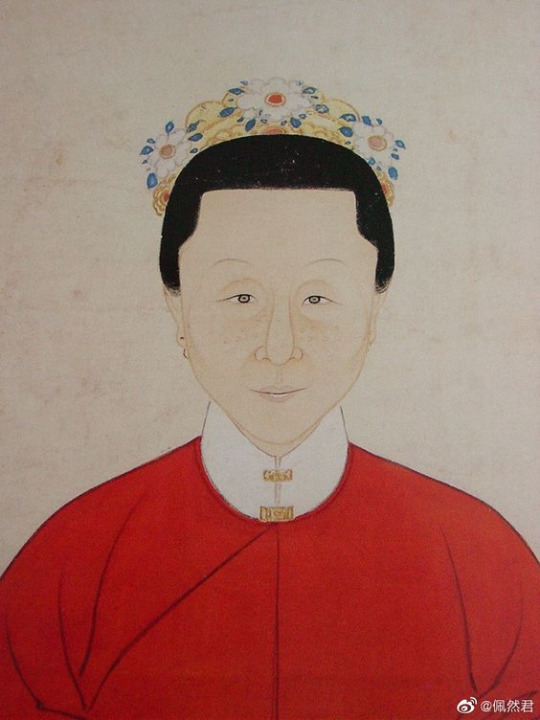
Source here
Late Ming Dynasty portrait, collar style 1.
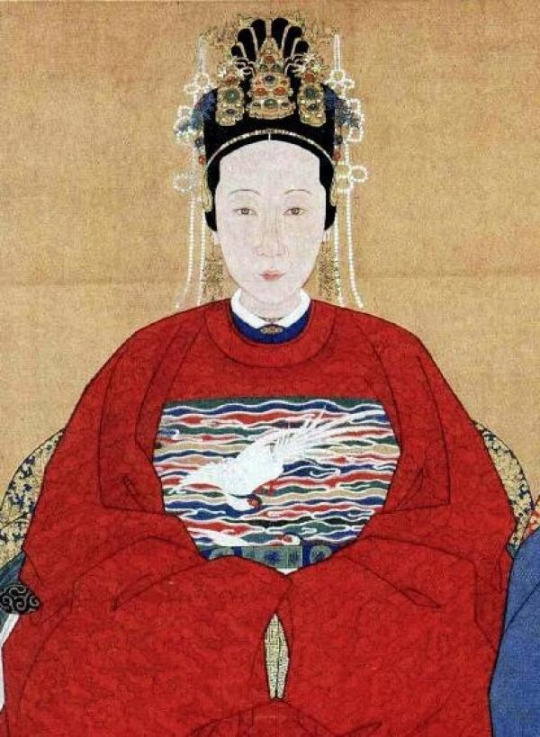
Source here
Late 16th century/early 17th century aristocratic lady wearing a standing collar robe underneath a round collar robe. The top of her collar is folded over. Collar style 1 variation 2.
Qing Dynasty (1644-1911)
This style of collar became the norm for Han Chinese women’s fashion in the mid to late 16th century and stayed that way throughout the 17th and 18th centuries. While the clothing silhouettes and accessories changed, the shape of the standing collar remained the same.
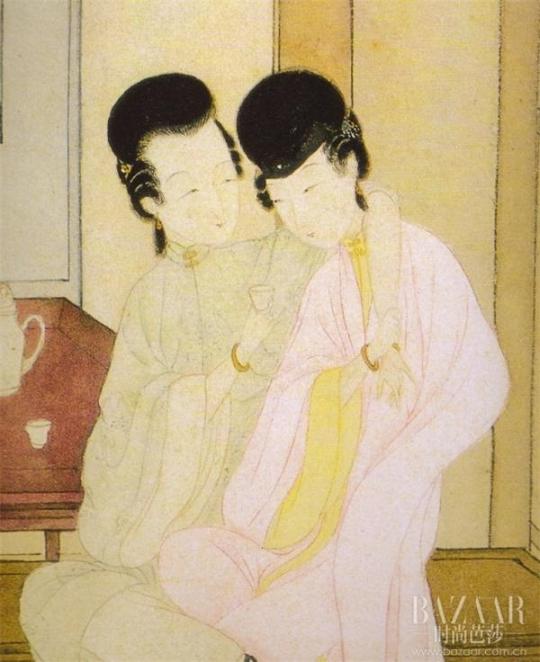
Source here
Late 17th century illustration for pornographic novel 肉蒲团 (1657). Collar style 1, but it became fashionable in the 17th century to have rows of piping around the neck for each button, so variation 3. Oh and wlw pride come throoouuuugh
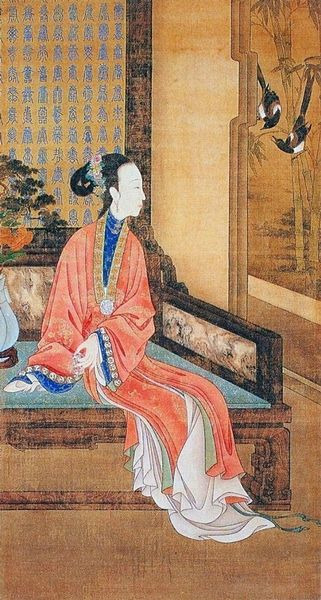
Source here
Early 18th century court painting, collar style 1 variation 3.
At some point in the late 18th century Han women decided it would be cool to use 盘扣 pankou, this fabric braided/knotted button of Manchu origin (more on Manchu dress later) on their collars instead of zimukou. The decoration also became more extravagant, with often rows of thick binding, piping or trim, corresponding to the decorations on the rest of the robe. It’s also slightly shorter, the upper button being at the very top of the collar. Let’s call this collar style 2.

Source here
(Presumably) late 18th century reverse glass painting showing collar style 2. The late 18th century deserves more attention, it’s such an important transitional period but also charming in its own way. This is true of European fashion of the period as well, I honestly love both places in the late 18th century.
In the beginning of the 19th century, the fashionable collar shape suddenly changed for some reason. It became extremely low, approximately only 1-2cm tall, only tall enough to accommodate one button. It still had crisp, rectangular edges. You could say this is another variation of collar style 2 but it is so iconic to the 19th century I think I’ll call this collar style 3.

Source here
Reverse glass painting ca. 1830. Han lady wearing a robe with collar style 3.
Now a brief look at Manchu womenswear. I am not an expert on Manchu historical fashion so tell me if I’m wrong. So the Manchus, who were apparently a confederation of Jurchen tribes from the area in what is northeastern China nowadays, invaded China successfully in the 1640s and remained the rulers of China until 1911 when they were replaced by the Republic of China. Throughout most of the Qing Dynasty Manchu women wore collarless robes, it was not until the mid 19th century that some Manchu women started to wear detachable collars to emulate Han women’s fashion, and not until around 1908 (!) when standing collars were actually added to their gowns themselves. Yes, period dramas did Manchu women dirty, poor gals have been dressed in the wrong costumes this, entire, time. The misrepresentation of Manchu historical fashion in the media in general is just fucking infuriating, but well, topic for a future post.

Source here
Late 17th century/early 18th century portrait of a Manchu lady. She is wearing a 衬衣 chenyi, a robe with straight sleeves, no slits and closed at the right side. It’s a casual gown worn for everyday activities. Her chenyi is collarless and the collar is closed by binding.
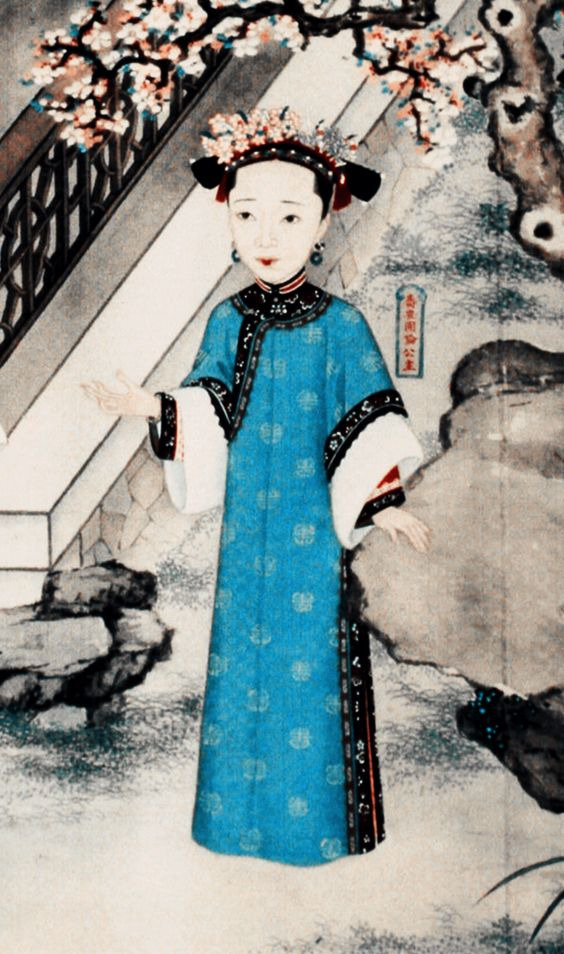
Source here
1840s/1850s court gown. She is wearing 氅衣 changyi (the bottom part of the first character should be 衣 not 毛 but this character is so obscure that it literally DOES NOT EXIST in the Chinese language anymore omg), a more elaborate style developed in the early 19th century with slits down both sides and wide trims along the collar, cuffs, side closure, side slits and hem. I have yet to see an extant example with a standing collar, all the changyi from the 19th century I’ve seen in museum collections are collarless, so the collar seen in paintings must’ve been detachable. Maybe some Manchu women liked Han women’s fashion and wanted to wear a detachable collar. I have, however, seen Manchu women’s vests and jackets with standing collars. These were similar to late 18th century Han women’s collars, so collar style 2.
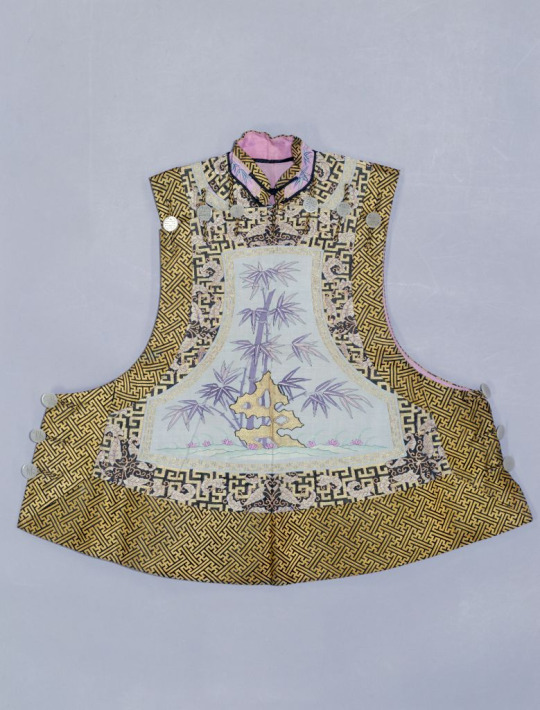
Source here
1890s/1900s women’s vest with collar style 2.
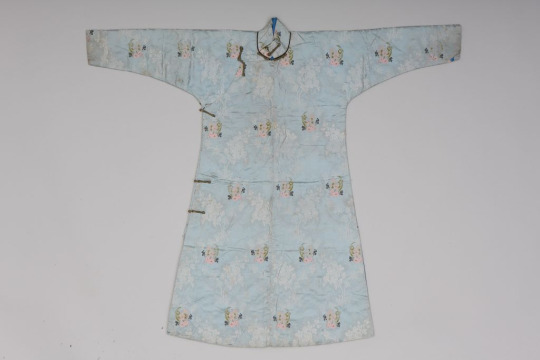
Source here
Ca. 1908. Chenyi with standing collar. If the passage of time is still not clear, notice the Western fabric used. Collar style 2.
At first glance this might look like a cheongsam but it is not. Chenyi did not have slits down the sides, unlike most 20th century cheongsam. It may have been a source of inspiration for cheongsam though, as I have explained in one of my 1930s posts, although the more obvious prototype for cheongsam was the changyi with slits and standing collars.
Let us now turn our attention to Manchu menswear, which is where things get complicated. In the 17th and 18th centuries, the Manchu riding habit, 行服袍 xingfupao, was a form fitting calf length robe with form fitting long sleeves and 马蹄袖 matixiu “horse hoof cuffs”, closed at the side with pankou. It was constructed in the same method as Han Chinese clothing. This original Manchu robe was collarless----I cannot stress this enough. The Manchus did not come barging into China wearing robes with standing collars goddamnit, get your facts right period dramas.

Source here
Portrait of Emperor Kangxi in a xingfupao. This is from the early 18th century already but the style didn’t change much so you get the idea. I love this color btw I think he looks great in it.
The xingfupao was an informal riding habit and only one small part in the gigantic system of Manchu court dress, the rules of which are well documented but I don’t bother to look them up. If you would like to do that, Google 大清会典. At one point in the early 18th century some Manchu dudes decided it was cool to add a collar to their xingfupao (like... Han women??) and it resulted in this:

Source here
An early example from the Kangxi era (1661-1722), a xingfupao with a standing collar of a contrasting color. The hem is detachable for horse riding (horse riding was an important aspect of Manchu culture and that influenced many of their fashion decisions). Judging by the fur lining I assume the standing collar was added for warmth in winter? I also saw some xingfupao with fur trim attached to standing collars so maybe that was the purpose.
Standing collars on xingfupao was constructed in a similar way to Han women’s collars, with rectangular edges and closed by two buttons. Pankous, which were unique to Manchu dress, were used instead of the Han zimukou. It appears that this collar was also soft and unstiffened, so it could be worn with the top bit folded over like in ye olde times (the 16th century). It’s important to note that xingfupao with a standing collar were not common at all, maybe a 1/20 probability to see in museum collections. Construction wise it’s similar to collar style 2 but it appeared earlier and was exclusive to menswear, so let’s call it collar style 4.

Source here
Qianlong era (1735-1796) portrait, xingfupao with standing collar of the same color folded over. Collar style 4 variation 2.
Another garment with a standing collar was the dress of the officials, known by white people as “Mandarins”. From the artworks and photographs I’ve seen, the collar only appeared in the outfit with a 行服褂 xingfugua, a button down tunic with straight, wide sleeves and slits at the front, back and sides. It was usually worn in combination with xingfupao, like how a shirt and vest are fixed combinations in European menswear. However, the collar of this kind of outfit was separate from the tunic itself. A plastron with an attached collar was worn underneath the robe and tunic (completely detachable collars were also used I think??) and the collar was buttoned from the inside. Not sure if this qualifies as a standing collar at all since it isn’t even attached to the robe itself, but anyway let’s just call this collar style 5.
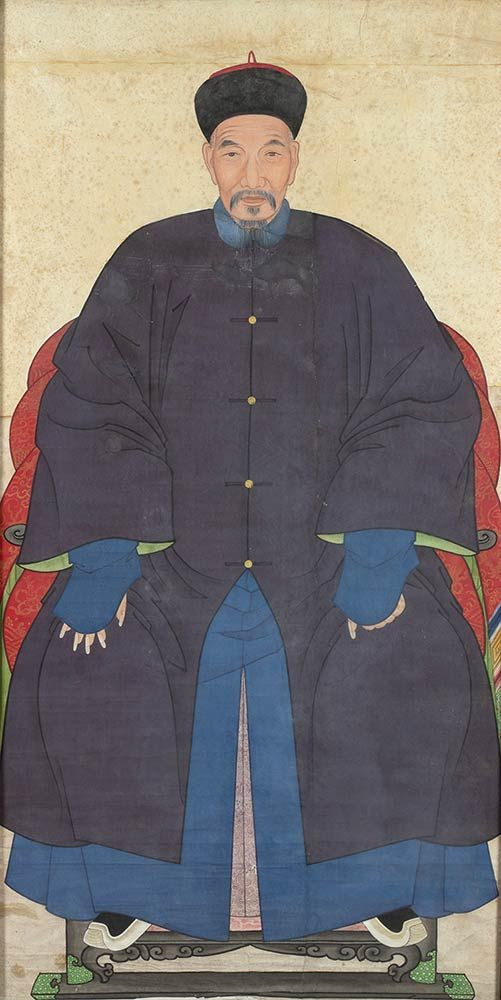
Source here
19th century portrait of an official. He is wearing a blue xingfupao, an indigo xingfugua and a blue detachable collar; a standard ensemble (well he’s also wearing pants and boots and stuff but that’s not the focus here). Collar style 5.
Oh I forgot to mention, after the Manchus took over China, they enforced their dress code on Han Chinese men but not Han Chinese women, so in the Qing Dynasty Han and Manchu menswear were one and the same but Han and Manchu womenswear were not.
I’ve only been talking about court dress so far, educated/well off civilian Han men would wear 长衫 changshan, a floor length robe, sometimes with a 马褂 magua, a short riding vest (derived from xingfugua), whereas poorer Han men would wear 短打 duanda, a short button down shirt, and pants. Well people who wore changshan also wore pants underneath but they’re not visible. All men wore pants tbh (incoming tangent), a while back when Harry Styles in a dress (which I stan) was making the rounds on social media some well meaning people were trying to find historical precedents for men wearing dresses and they named Chinese historical clothing as an example. I just wanna say, while I appreciate the sentiment, the harsh reality was that historical Han Chinese fashion was extremely gendered (except for a few brief time periods and a few select garments). Pants were reserved for men and skirts for women, the long gown like garments seen on men in historical portraiture were all robes, not dresses; you wouldn’t consider a long coat or bathrobe a dress nowadays, would you? Men always wore pants as undergarments while women wore petticoats. However I think that’s great for illustrating how our perception of whether a garment is masculine/feminine could change over time and that gender is socially constructed. Back to the main topic, to my knowledge, magua never had collars because it was a vest, changshan commonly had collars and duanda sometimes did too. I’m not sure when the standing collar began to appear on changshan, maybe when the court xingfupao gained collar style 4 it stuck in civilian fashion, maybe it was some point in the 19th century.
Anyway, fast forward to the late 19th century, the men’s changshan had a tall standing collar but again it was different to everything we’ve seen so far. It was exceptionally tall and had a smoothly tapering edge closed by only one pankou at the bottom. This resulted in a huge v shape gap down the middle. It’s still unstiffened but because of the lack of a rectangular edge it couldn’t be worn folded over. Let’s call this collar style 6.

Source here
Late 19th century/early 20th century portrait of a man. Changshan with collar style 6.
Let’s finish this part with Han women’s collars in the 1890s and 1900s. Around this time Han womenswear began to modernize and become simpler, but that trend did not apply to collars: the collars of Han women’s robes suddenly became unnaturally tall. They were so tall that they touched the wearer’s cheeks and couldn’t be closed at the front at all, kind of resembling Regency era European men’s collars?? This style of collar was oftentimes called 元宝领 yuanbaoling, ingot collar, or 马鞍领 ma’anling, saddle collar, after the object it resembles. Let’s call all of these tall collars that touch the wearer’s face collar style 7, but bear in mind these had a lot of variations.

Source here
Photograph from the 1900s. This could be categorized as a cursed variation of collar style 6 judging from how it only has one pankou and a tapering edge instead of a rectangular edge. But like, belle époque Chinese collars are a whole other species, so let’s comfortably call it collar style 7.

Source here
More collar style 7 representation. This collar style will never stop being funny to me, like just look at it it’s so tall.
So, in summary:
Collar style 1: OG Ming Dynasty standing collar, in fashion from the 16th to mid 18th century. Tall, unstiffened, rectangular edges. Closed with two zimukou. Could have piping (17th & early 18th century). Could be worn with top bit folded over (16th & early 17th century). Worn by Han women.
Collar style 2: developed from collar style 1, popularized in the late 18th century. Medium height, unstiffened, rectangular edges. Closed with two pankou/other fabric buttons. Commonly has binding, piping or trim. Worn by Han women in the late 18th century, partially adopted by Manchu women in the late 19th century.
Collar style 3: developed from collar style 2, exclusive to the 19th century. Extremely short, unstiffened, rectangular edges. Closed with one pankou. Commonly has binding, piping or trim. Worn by Han women.
Collar style 4: collar style 2 but simpler, appeared in the late 17th/early 18th century. Tall, unstiffened, rectangular edges. Closed with two pankou. Commonly plain. Worn by Manchu & Han men.
Collar style 5: detachable standing collar, a staple of official’s uniforms throughout the Qing Dynasty. Medium height, unstiffened, rectangular/rounded edges. Buttoned from the inside. Always plain. Worn by all officials (exclusively men in this era).
Collar style 6: civilian men’s collar characterized by v shape gap at the front, I don’t know when it first appeared, some point in the Qing Dynasty. Tall, unstiffened, rounded and dramatically tapering edges. Closed by one pankou. Worn by civilian Manchu & Han men.
Collar style 7: cursed belle époque (1890s & 1900s) women’s collars that touched the wearer’s face. Extremely tall, stiffened, both rounded and rectangular edges existed. Closed by one pankou at the bottom but sometimes had more pankou for ornamental purposes. Worn by Han women in this period.
Join me next time as we dive into the Republican era where things get extra complicated.
#hanfu#historic fashion#chinese fashion#chinese history#ming dynasty#qing dynasty#16th century#17th century#18th century#19th century
349 notes
·
View notes